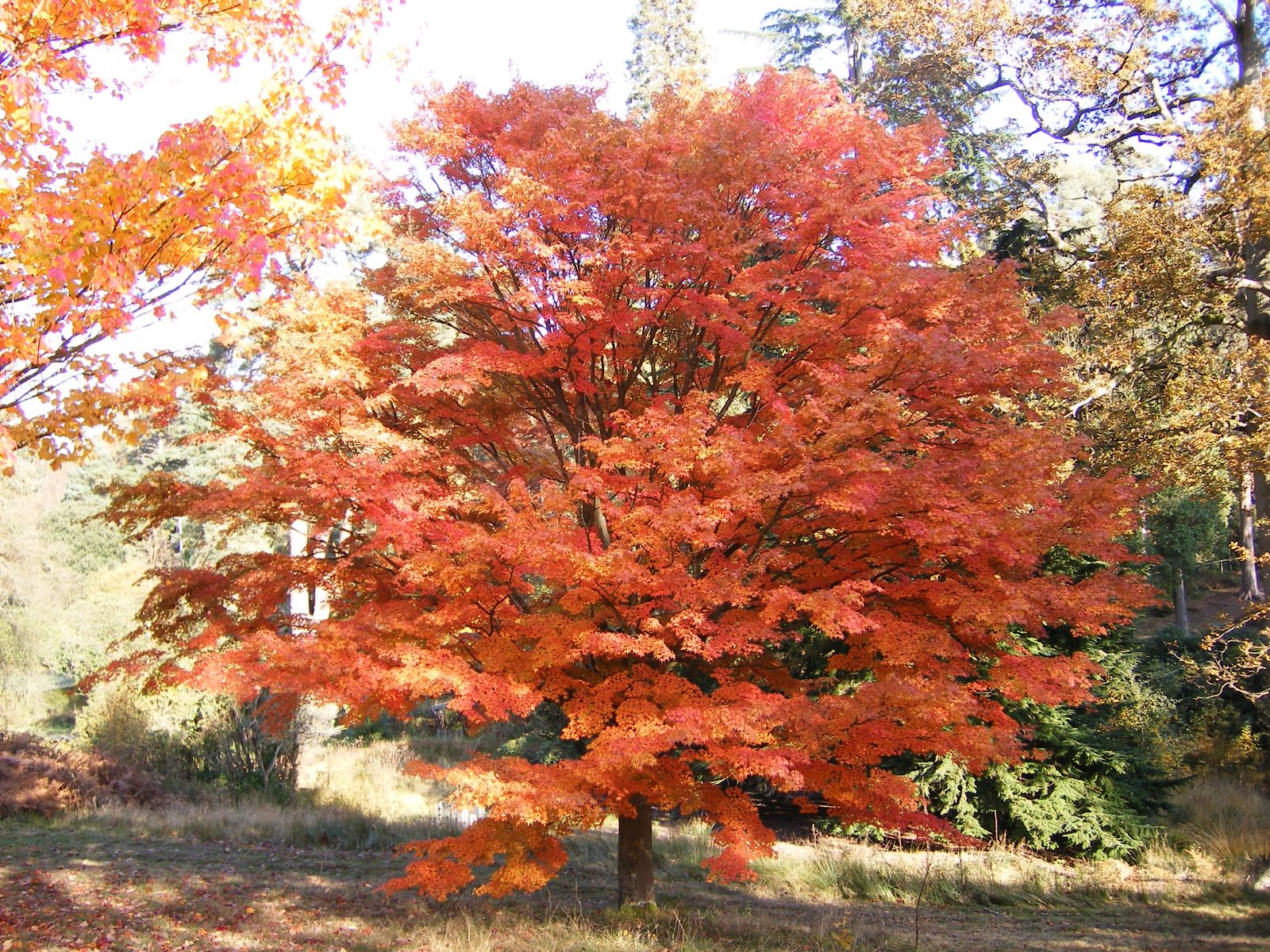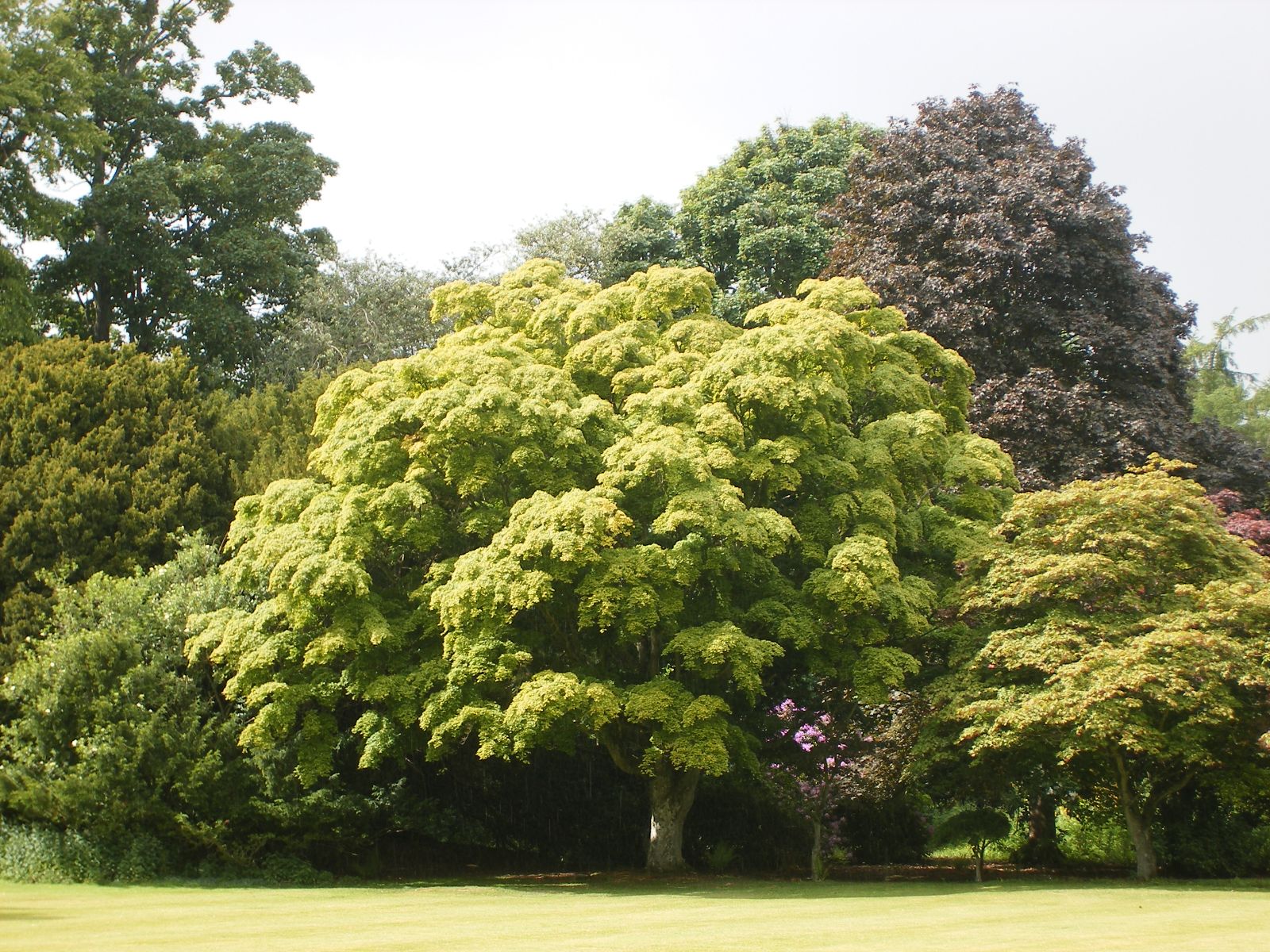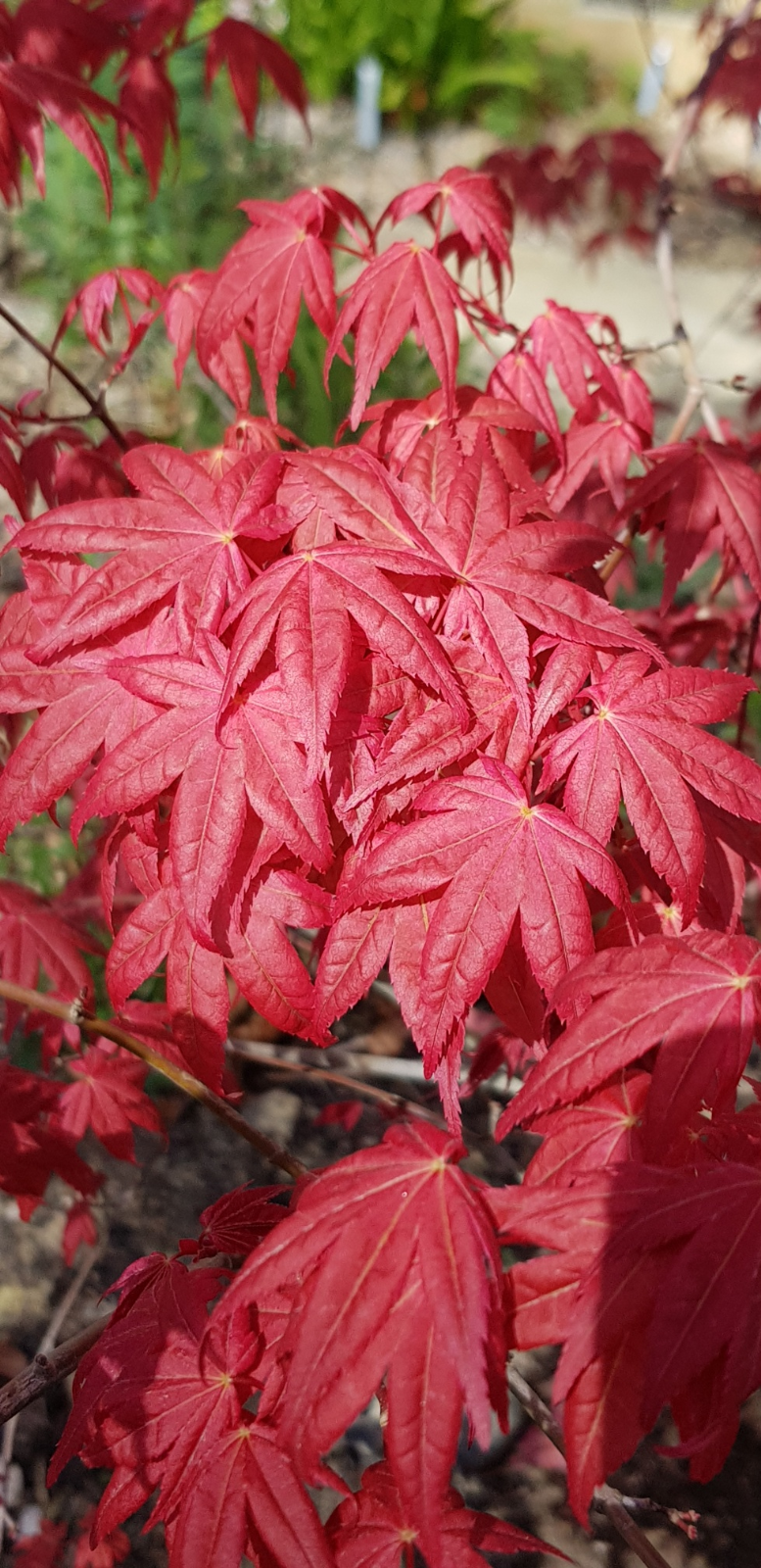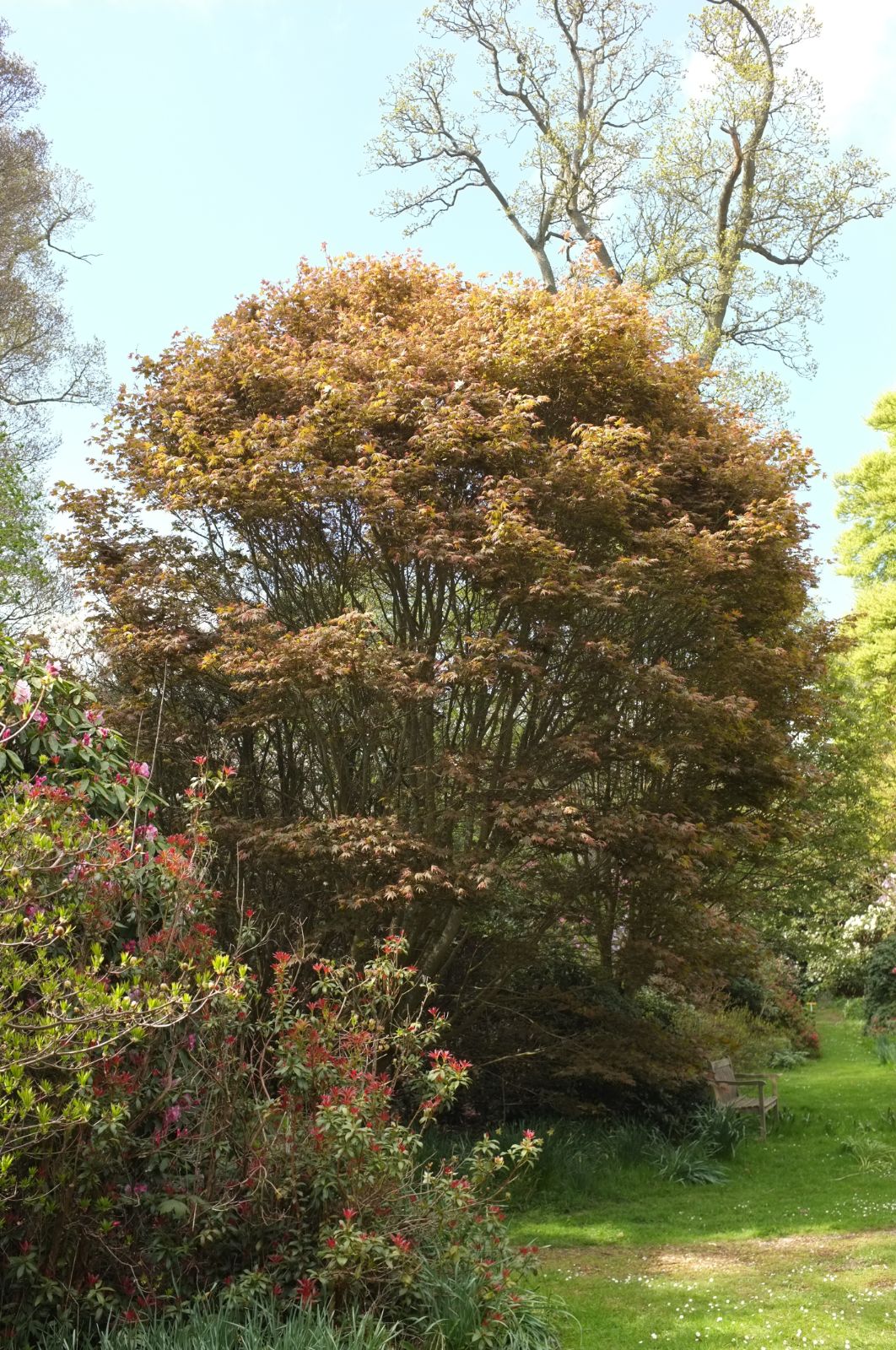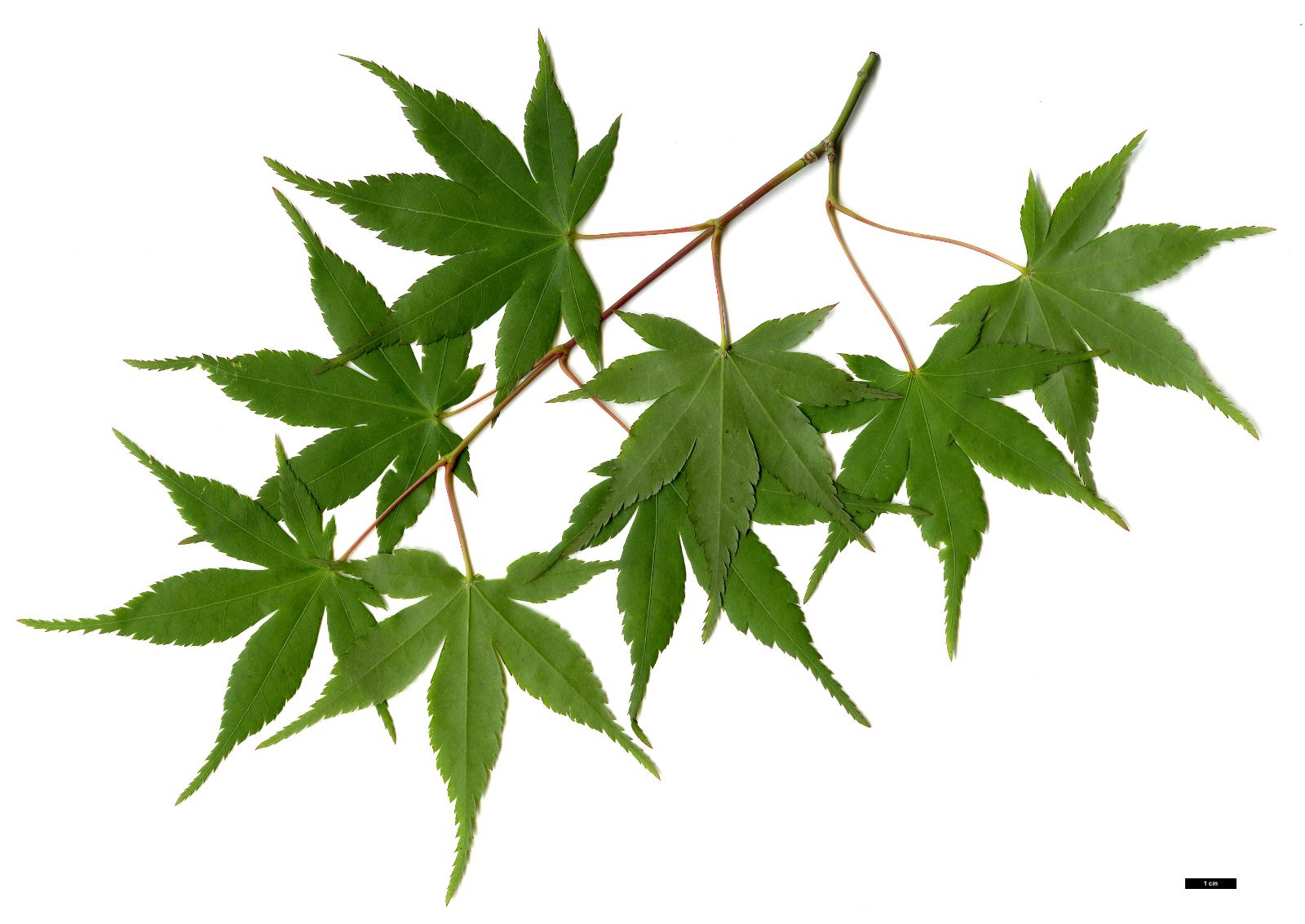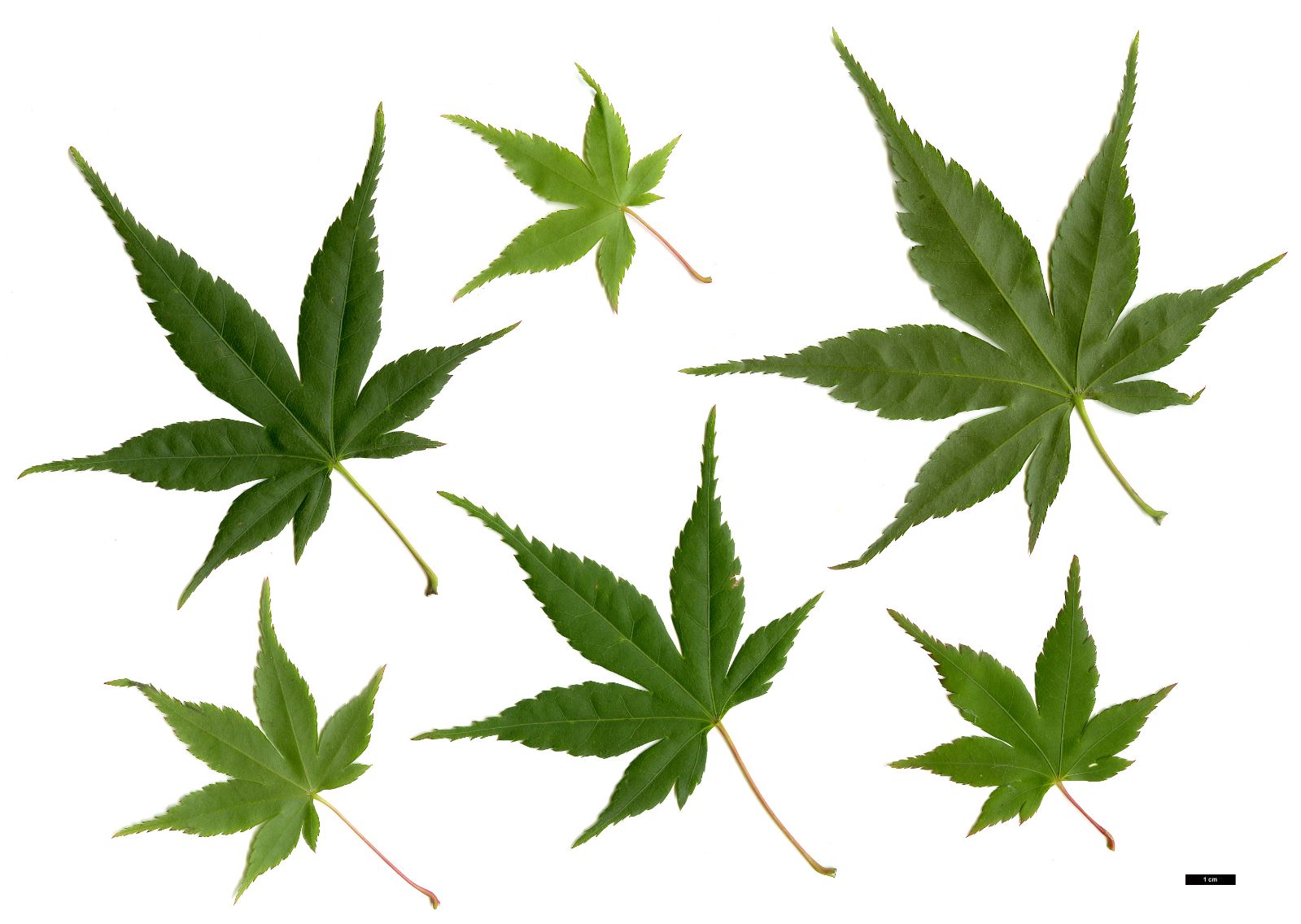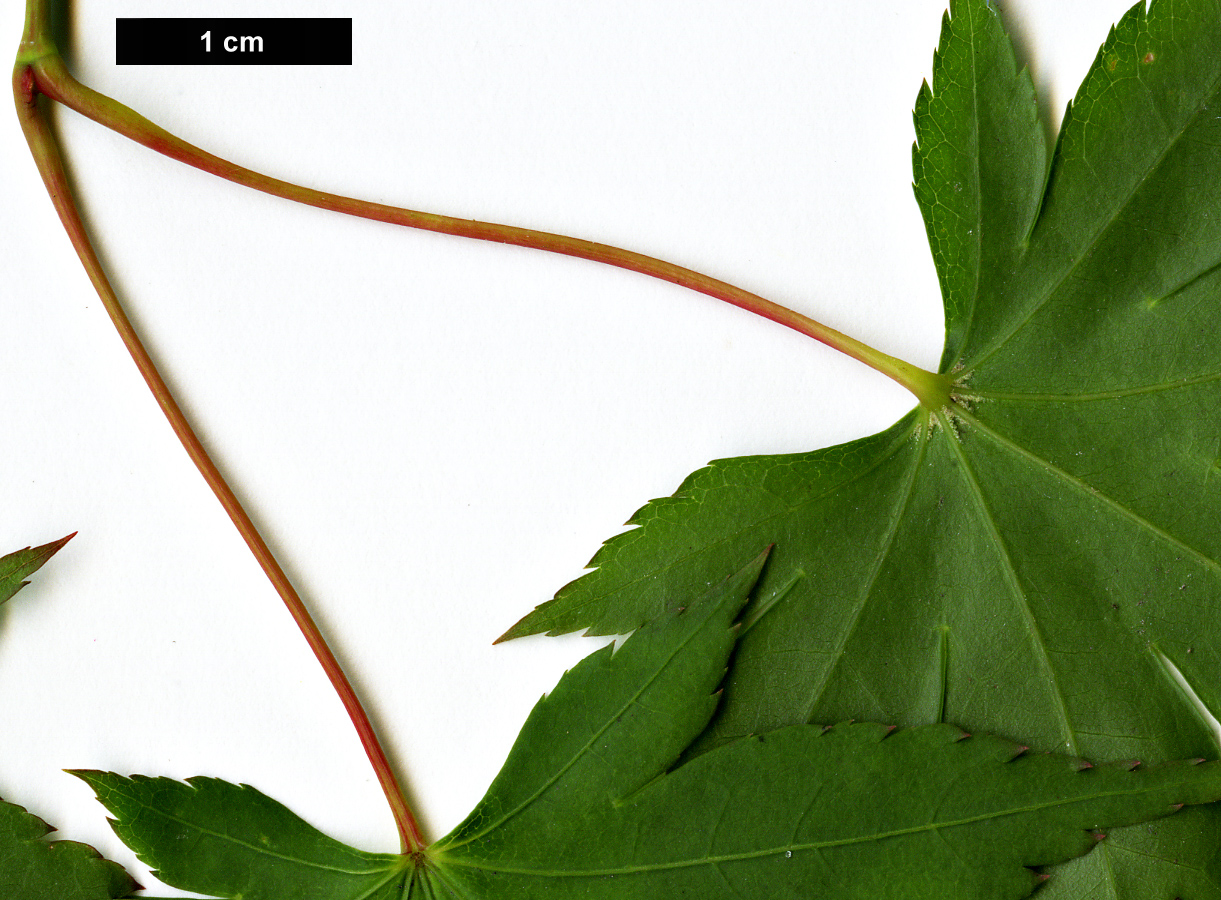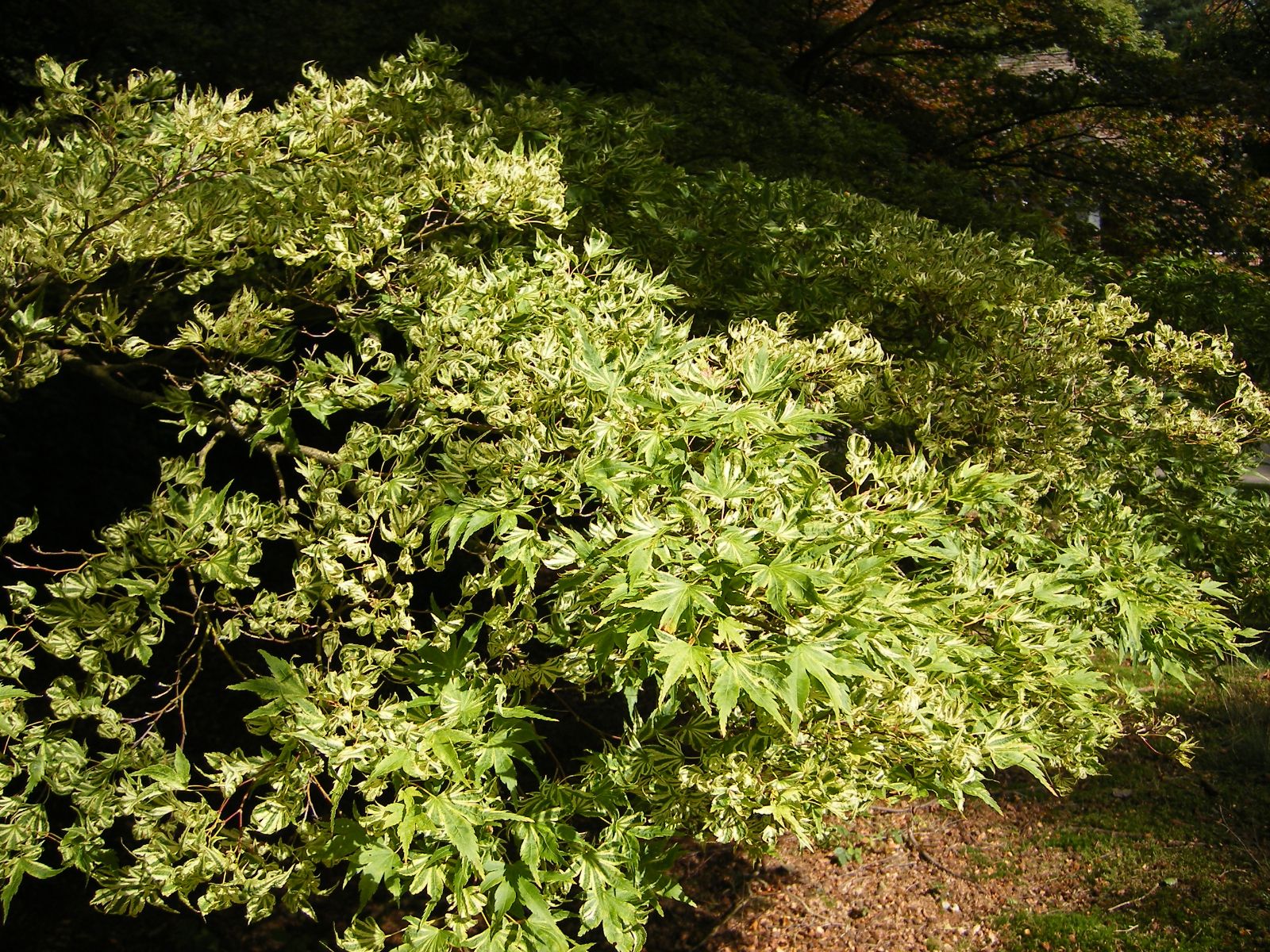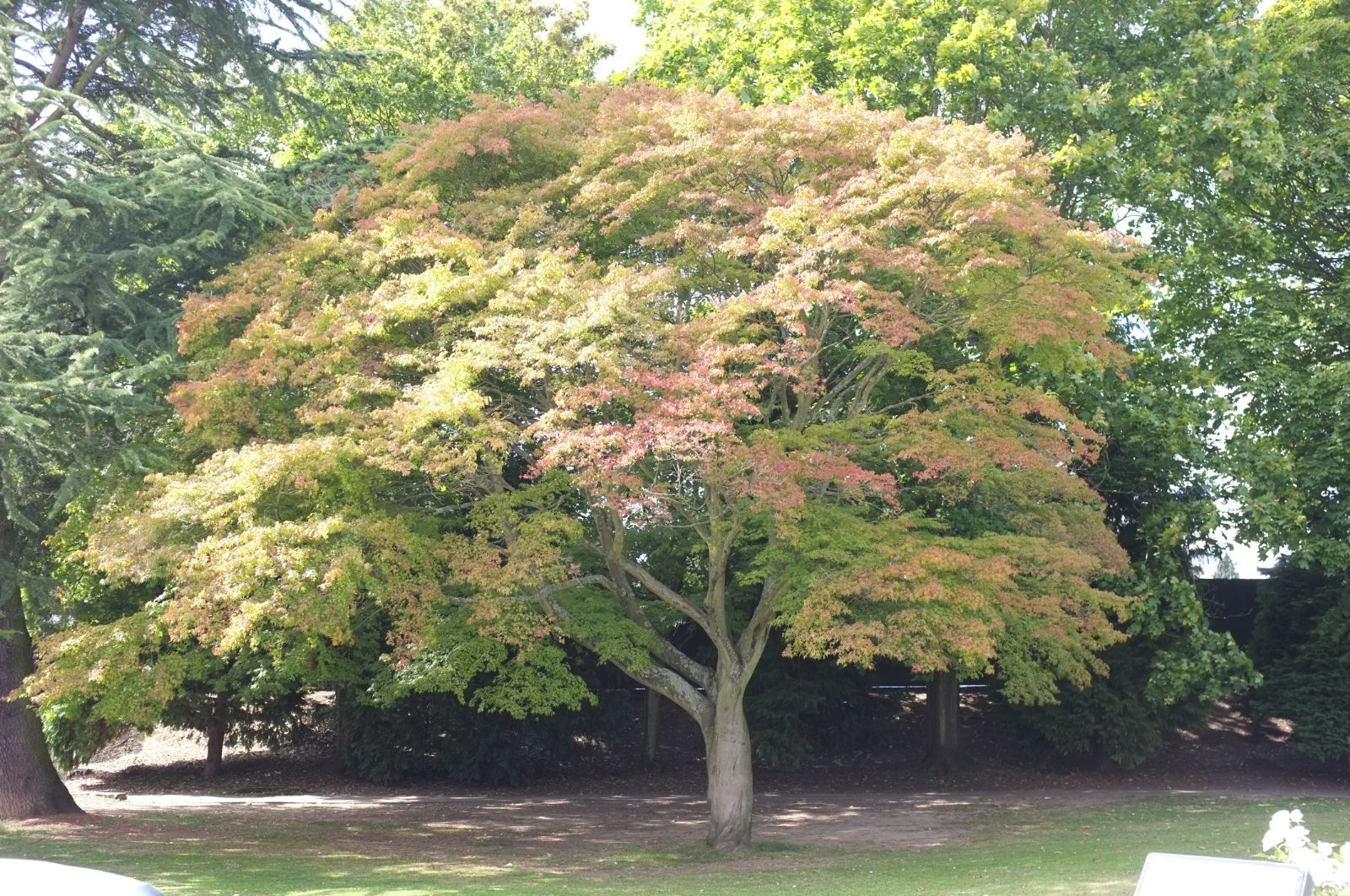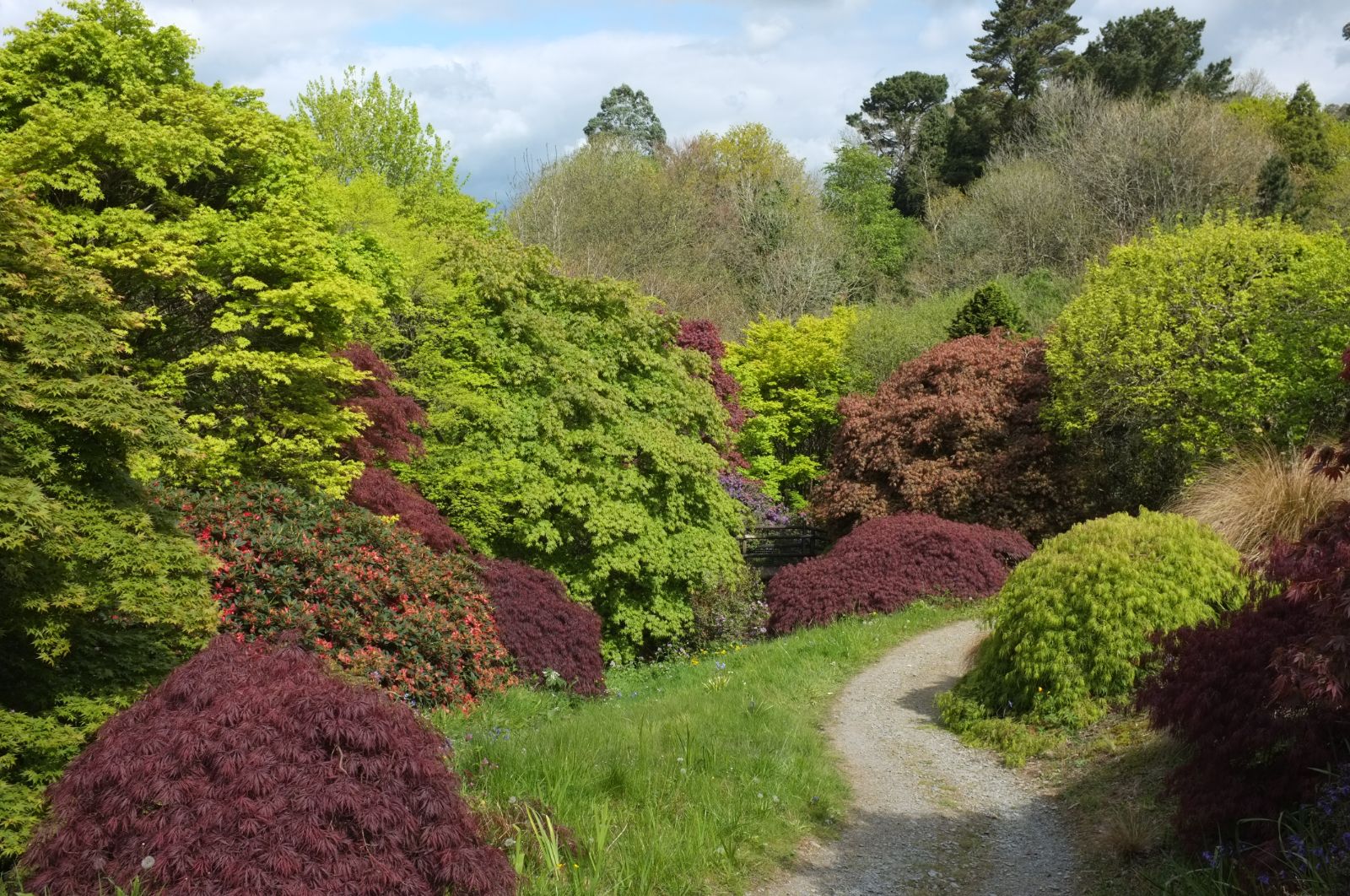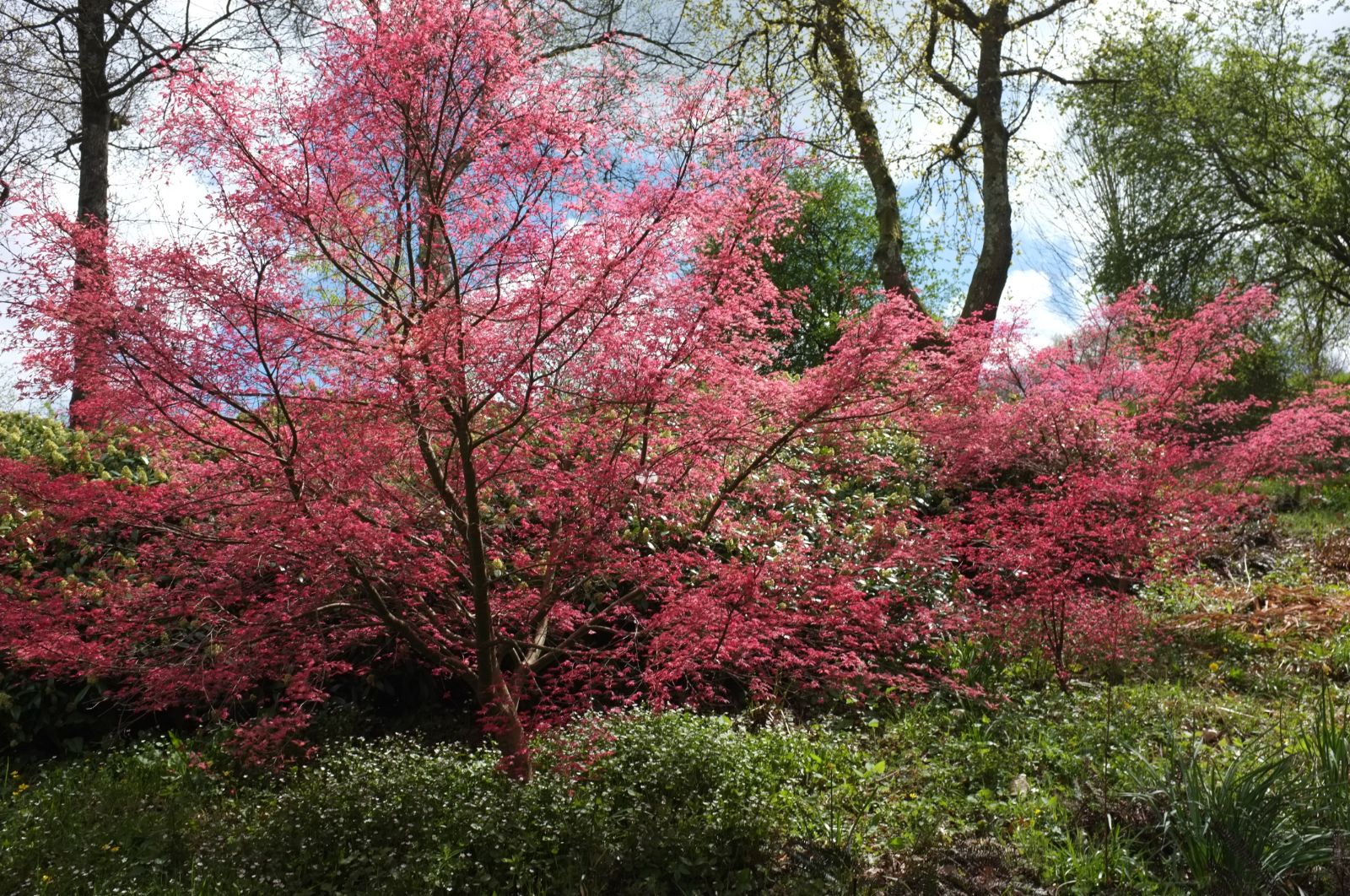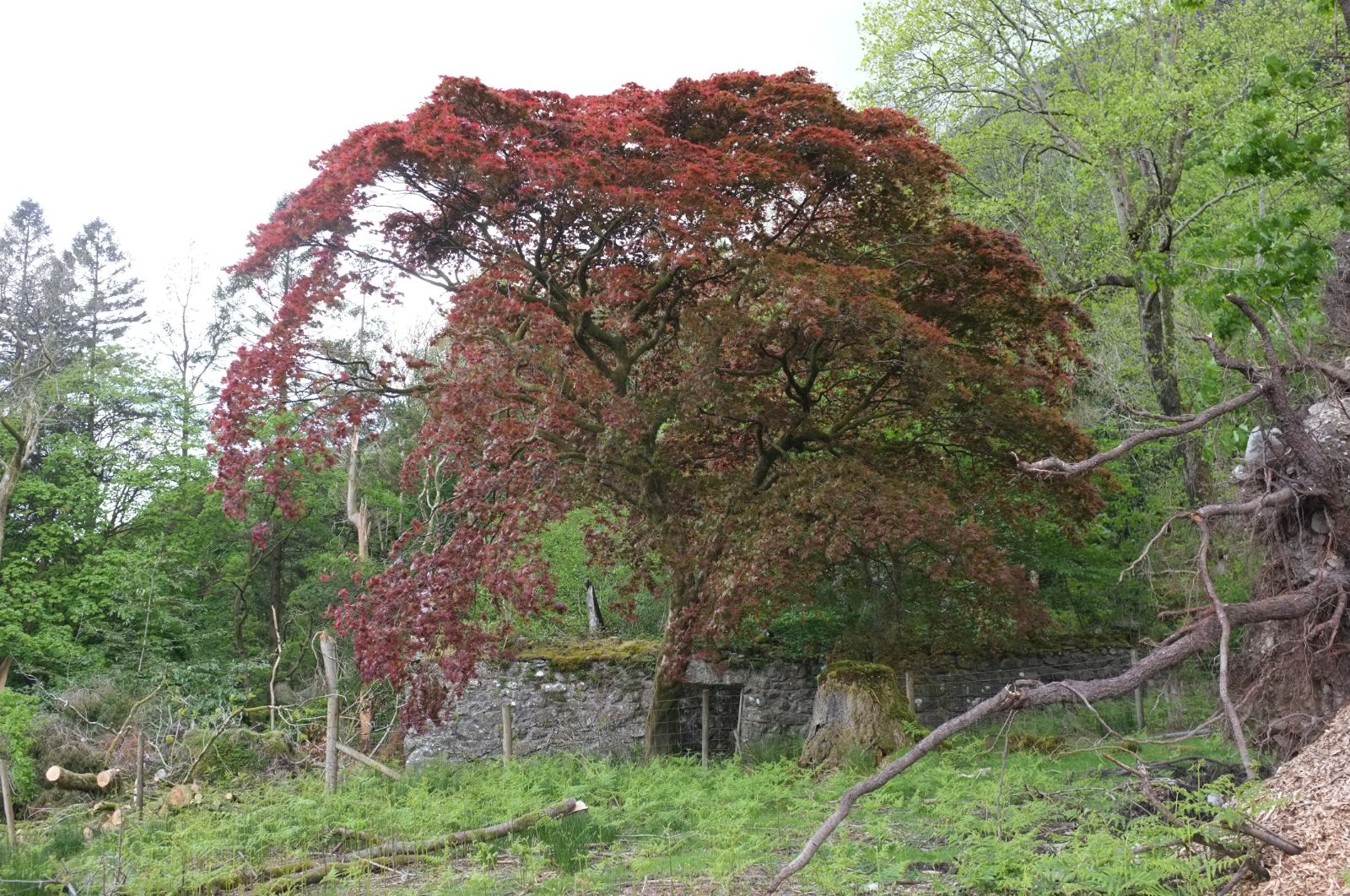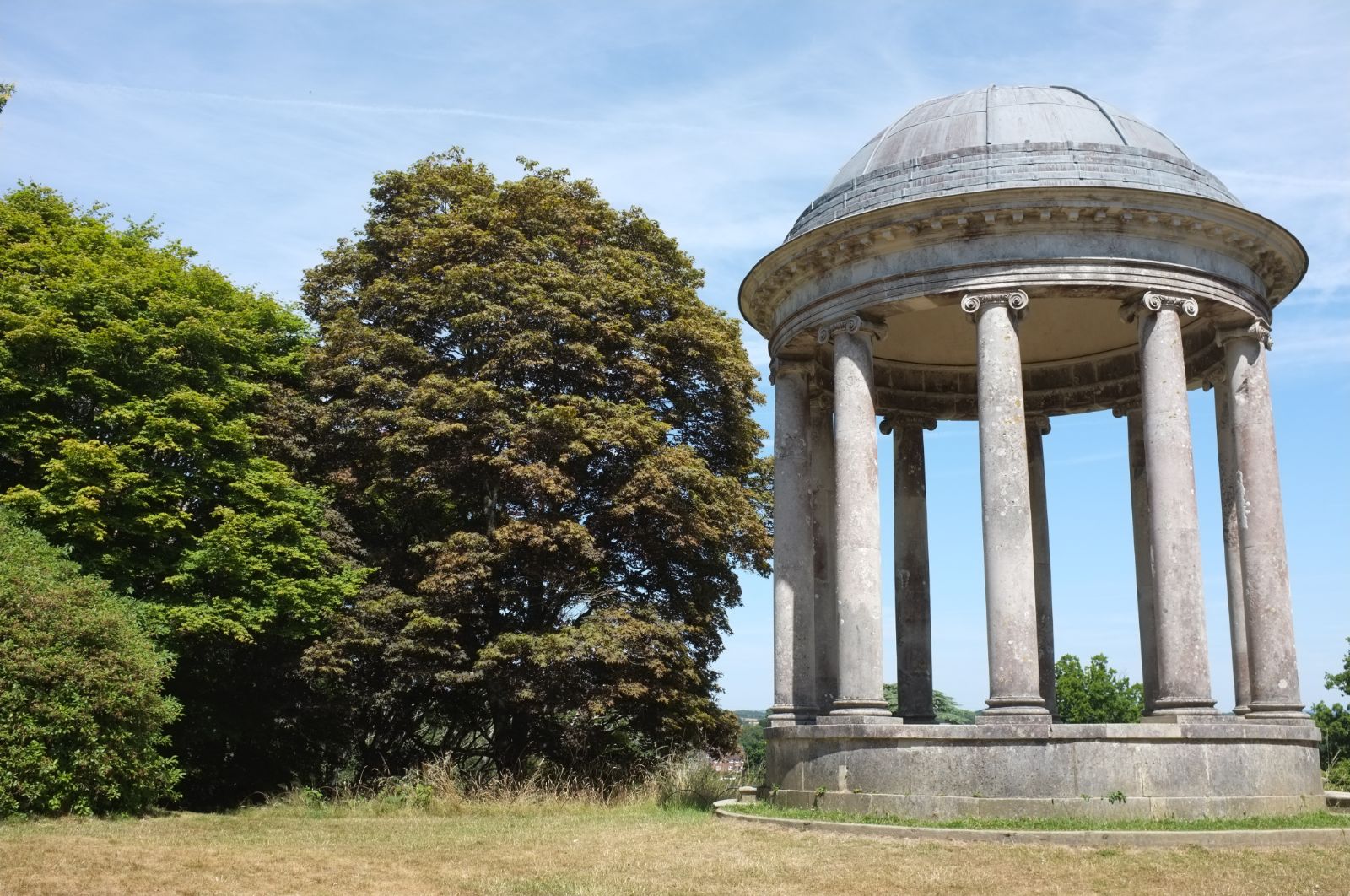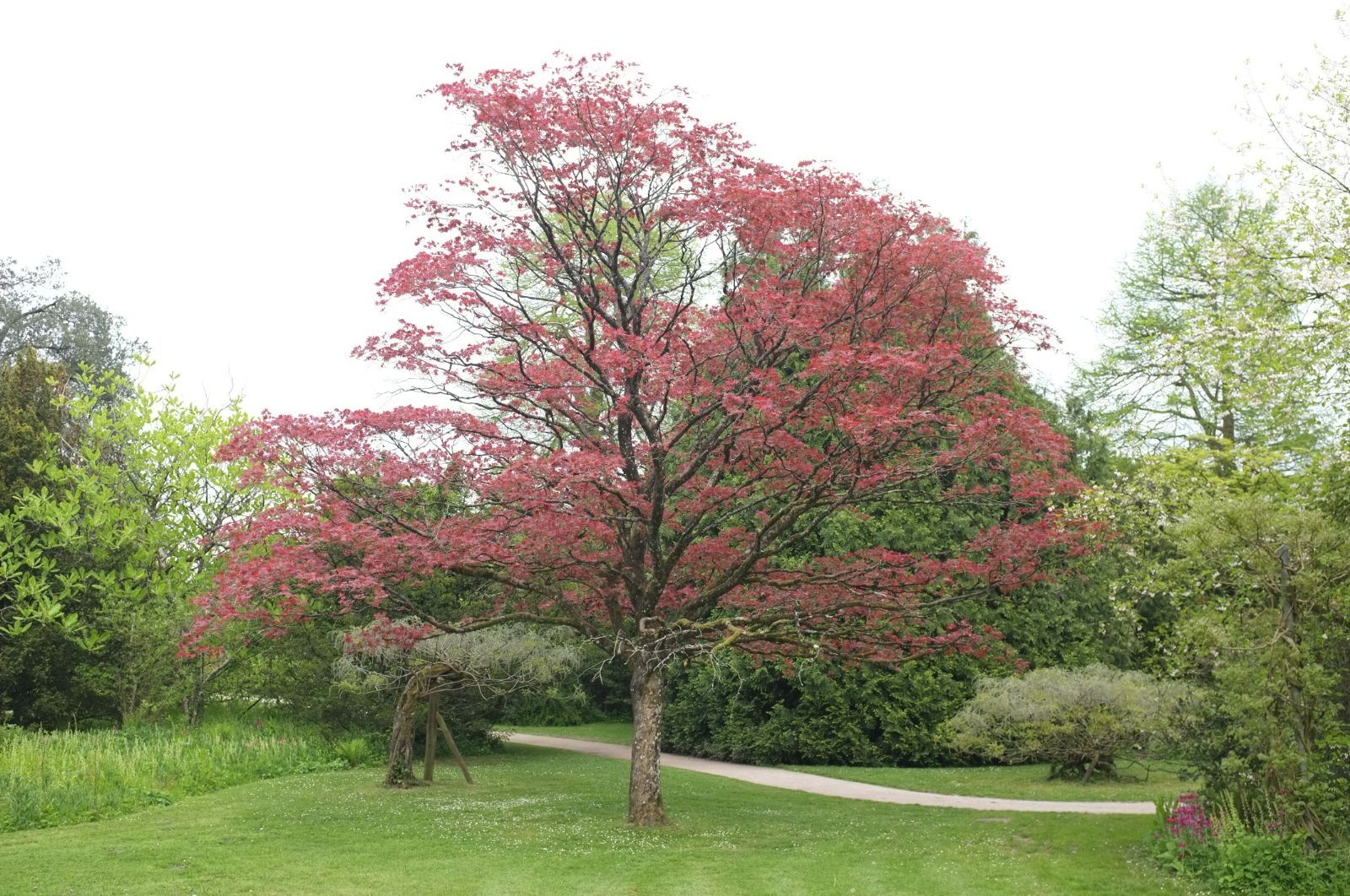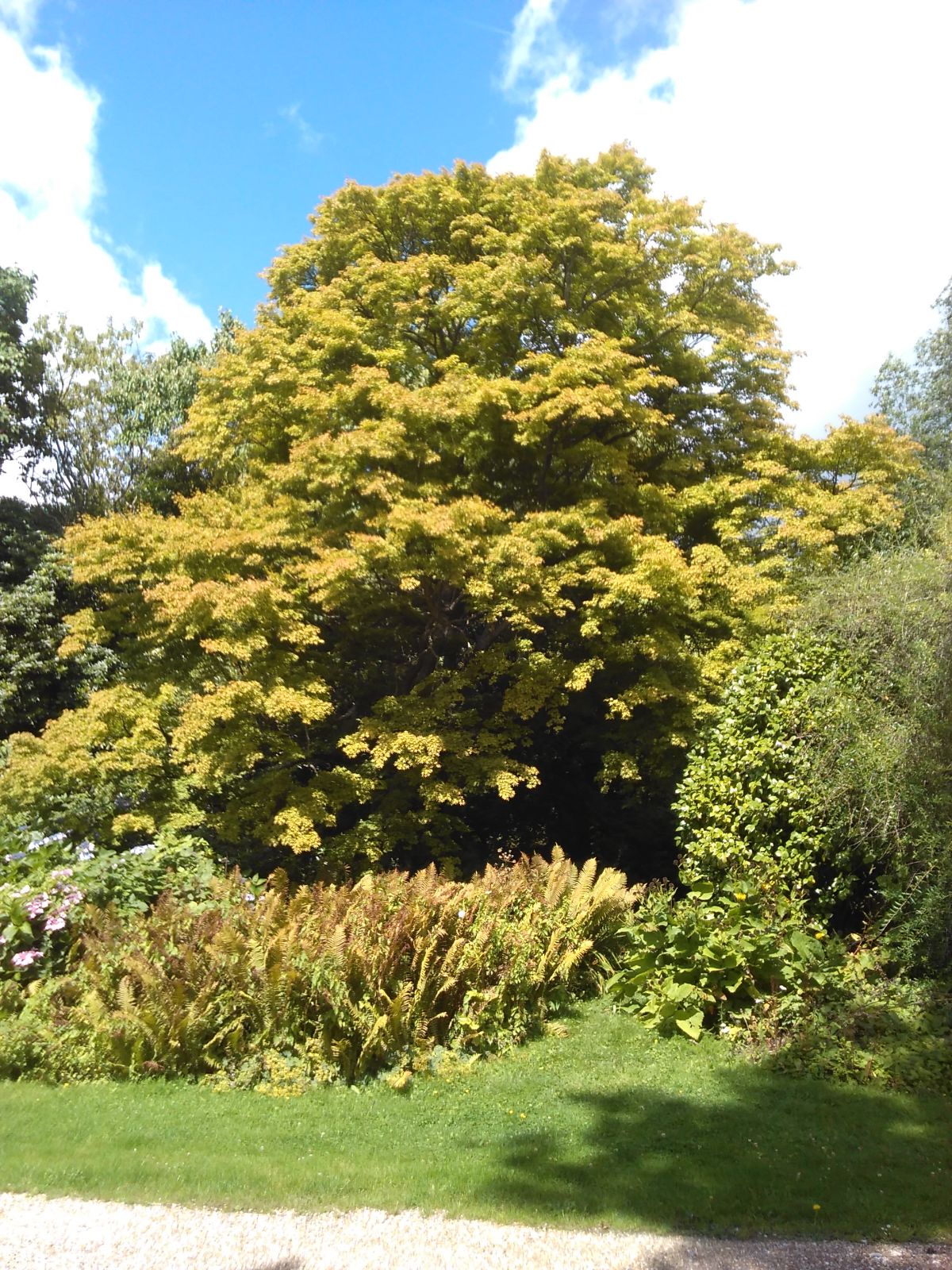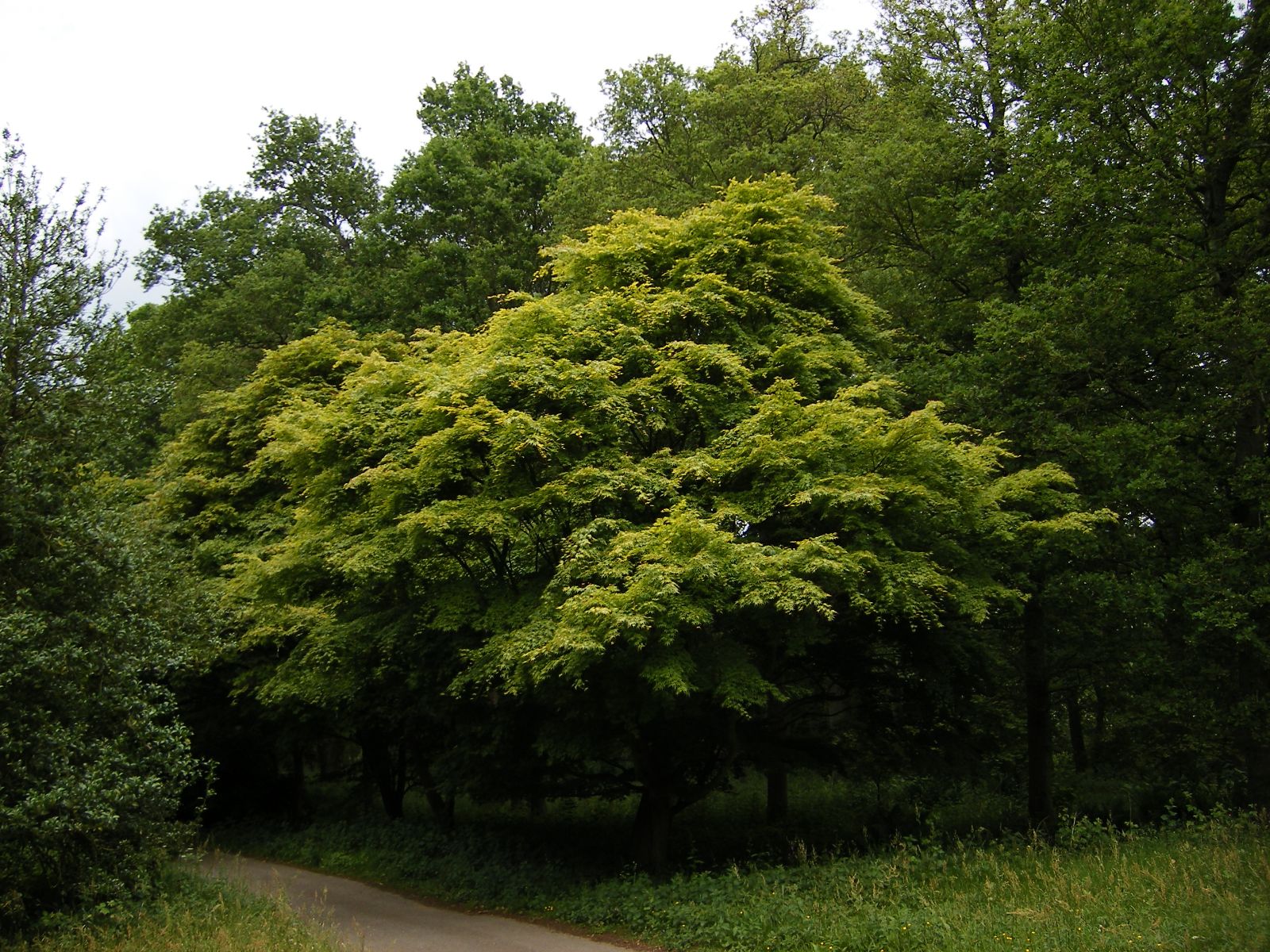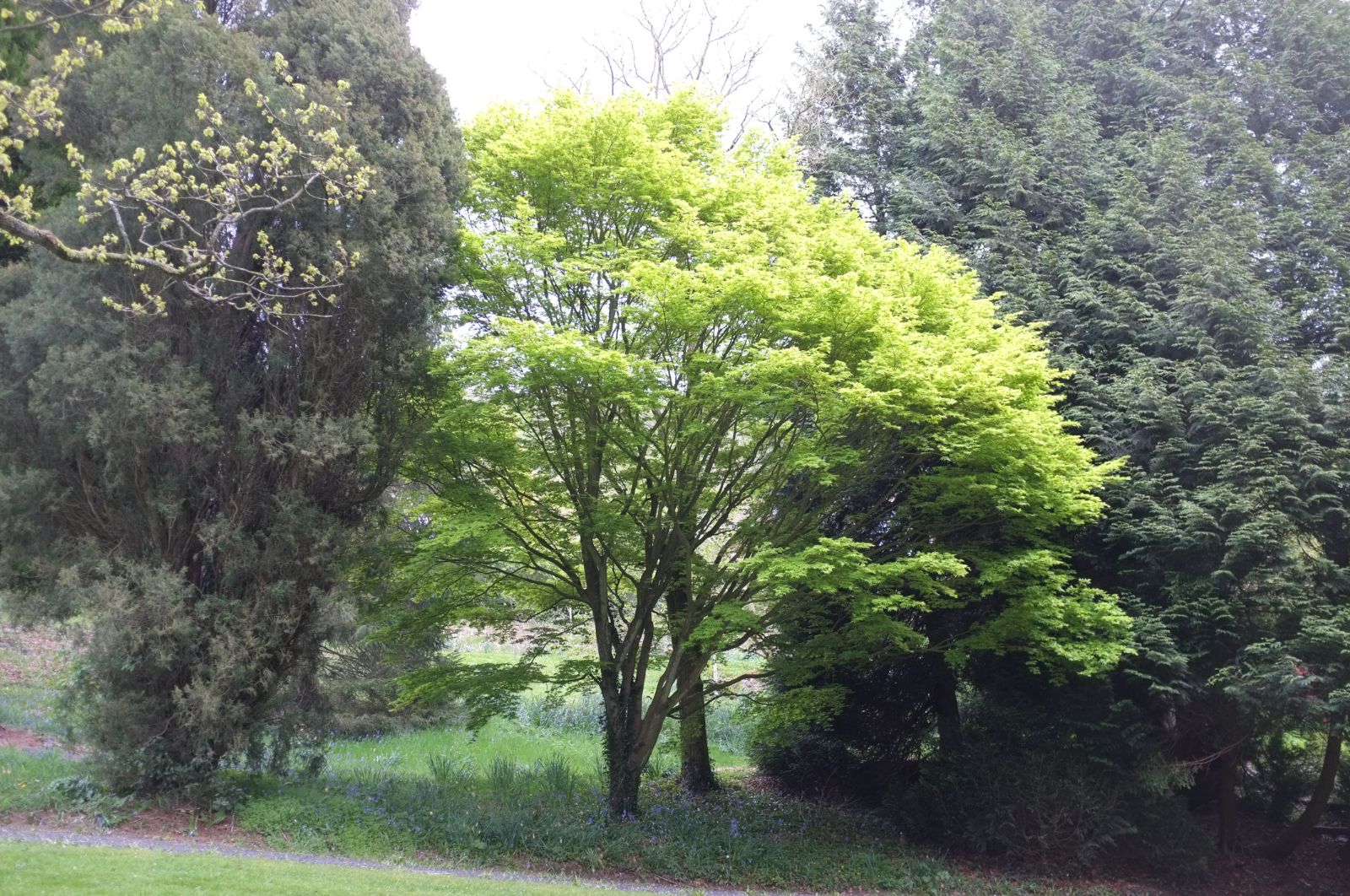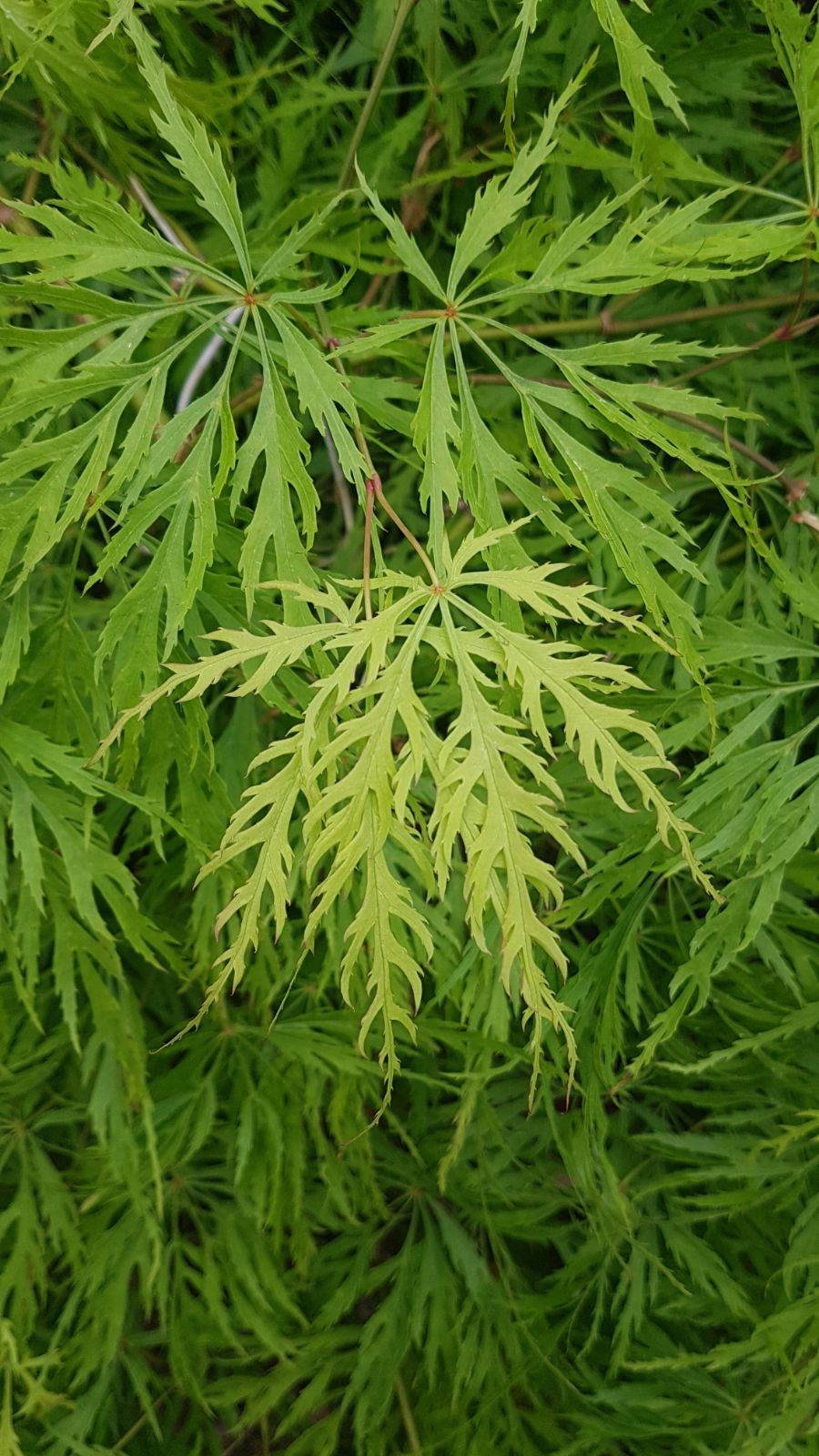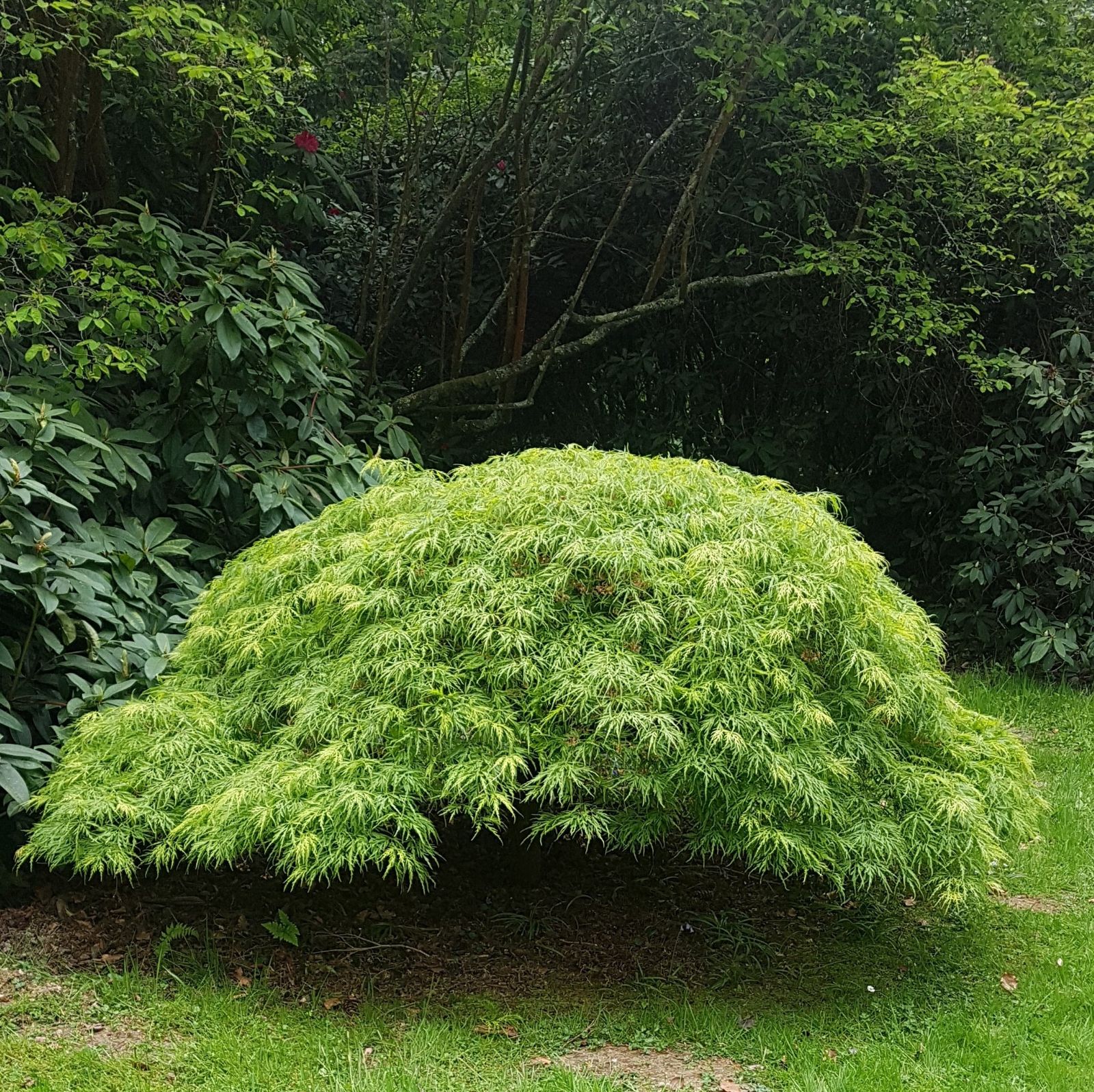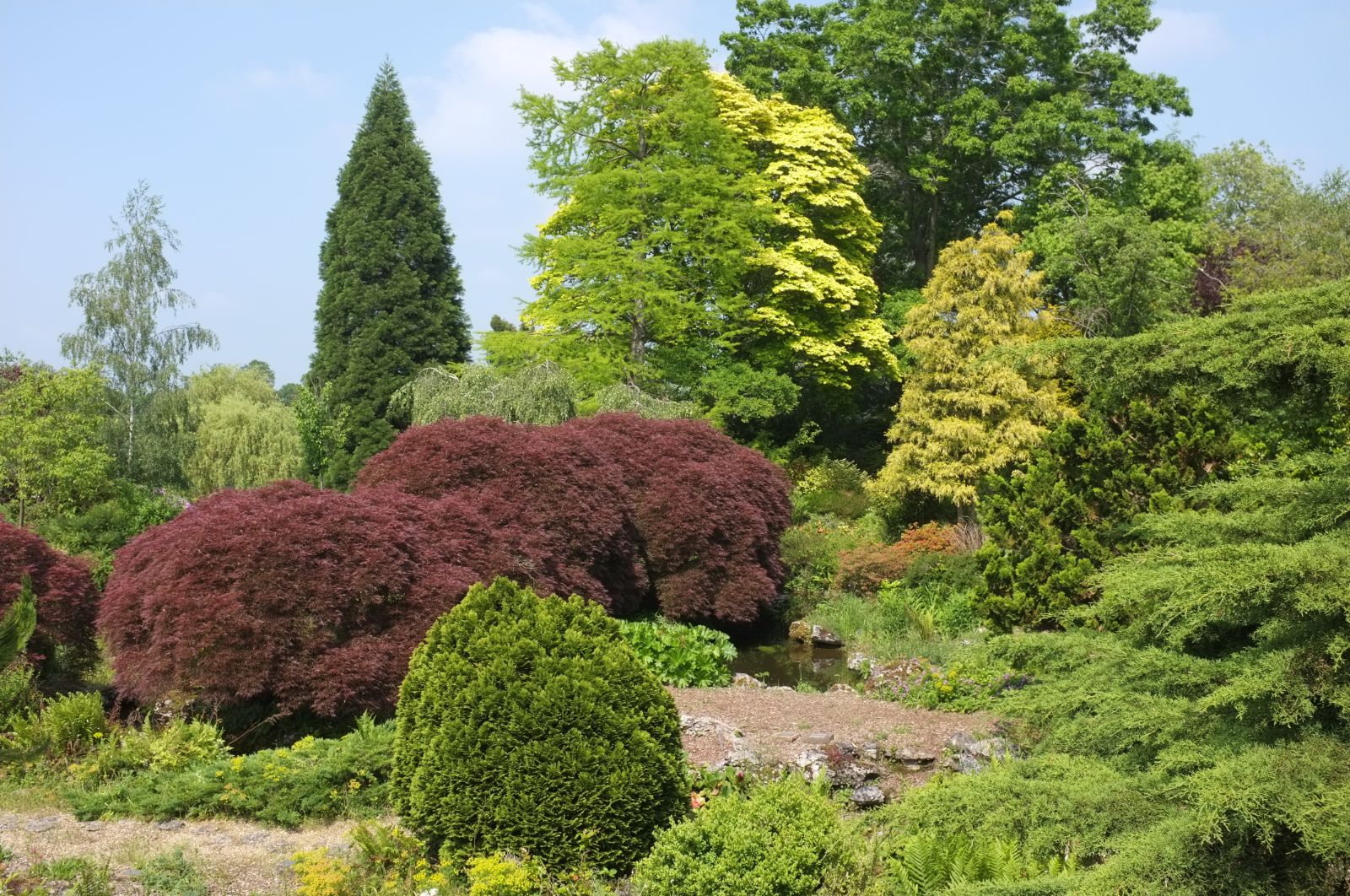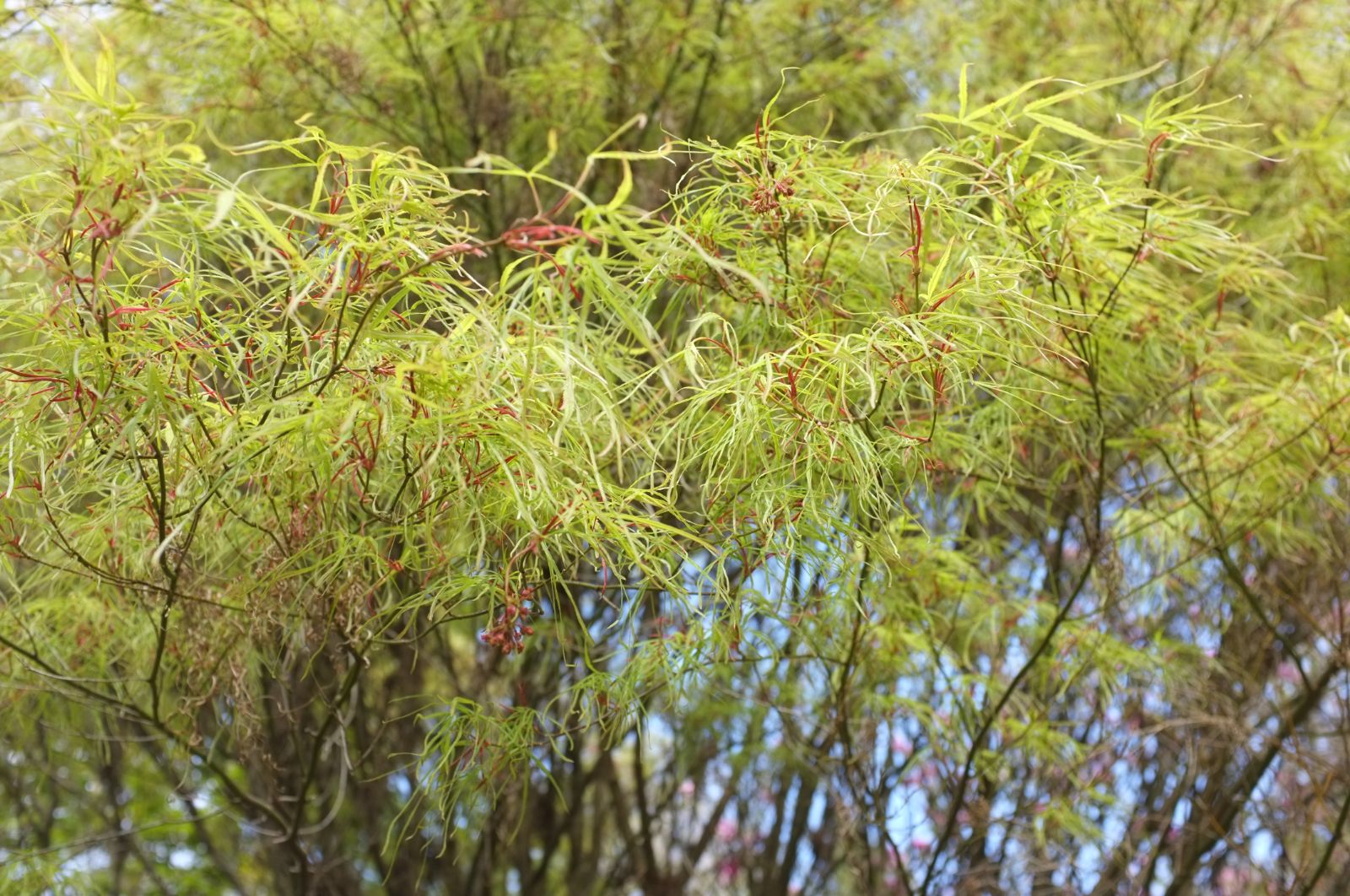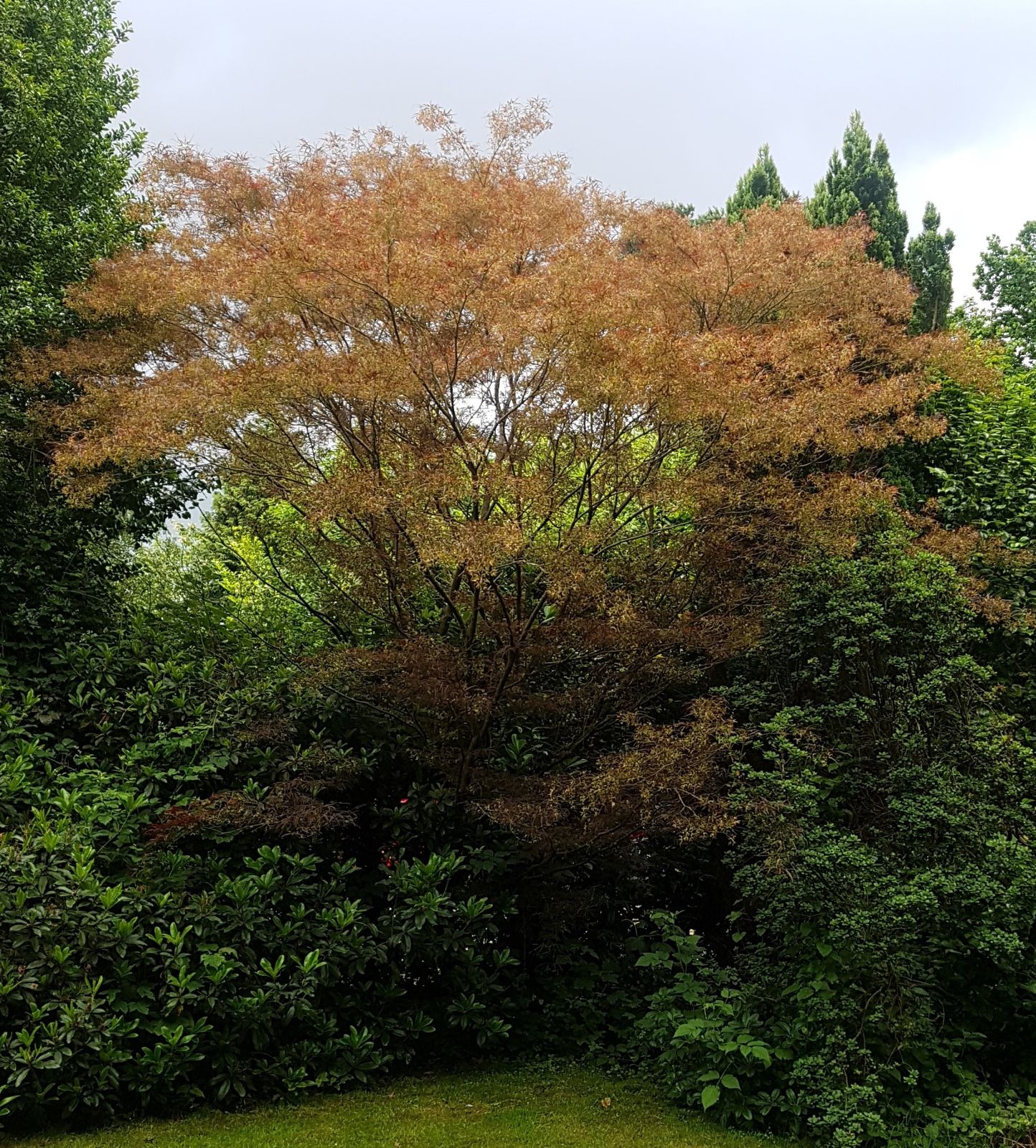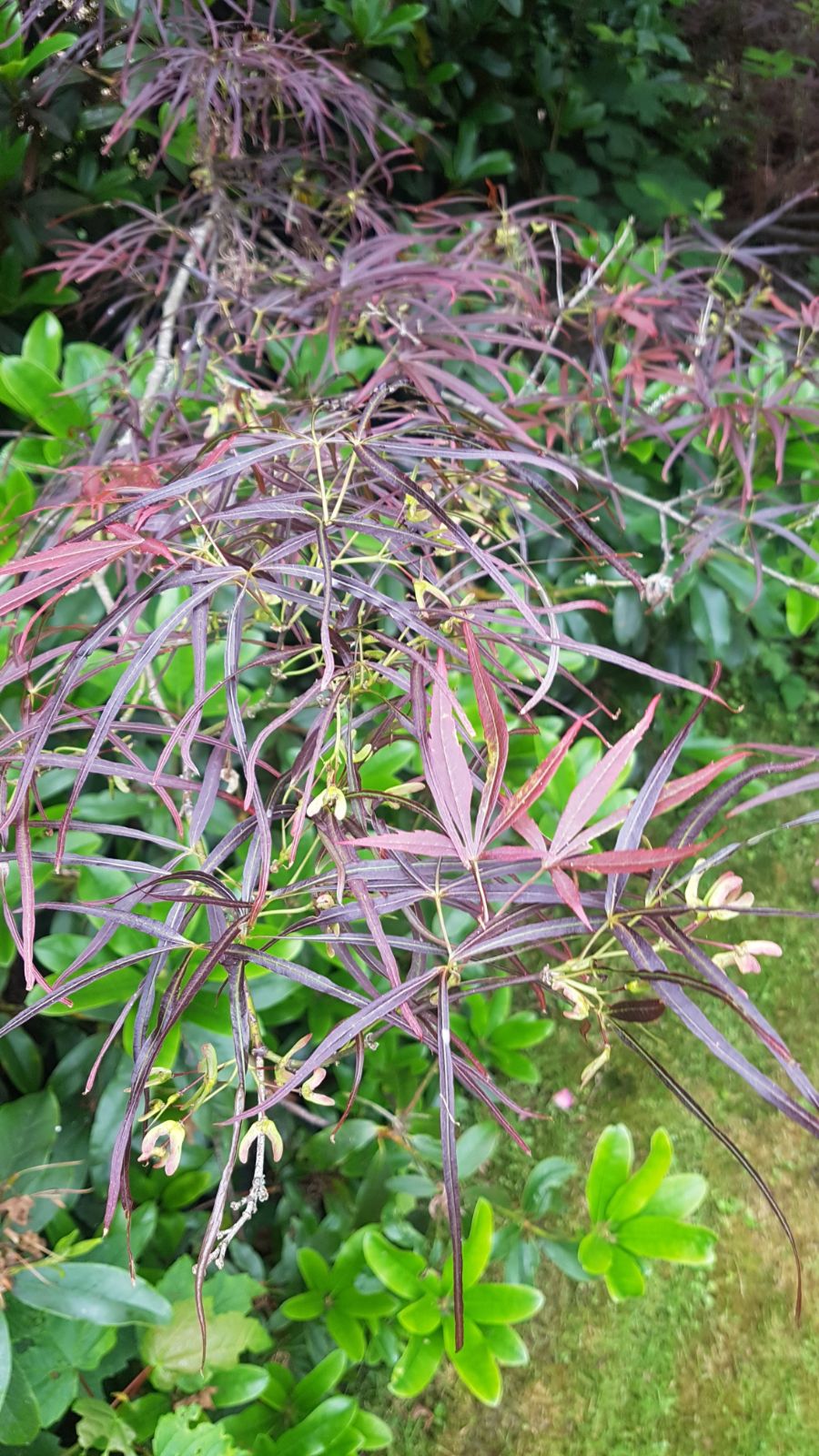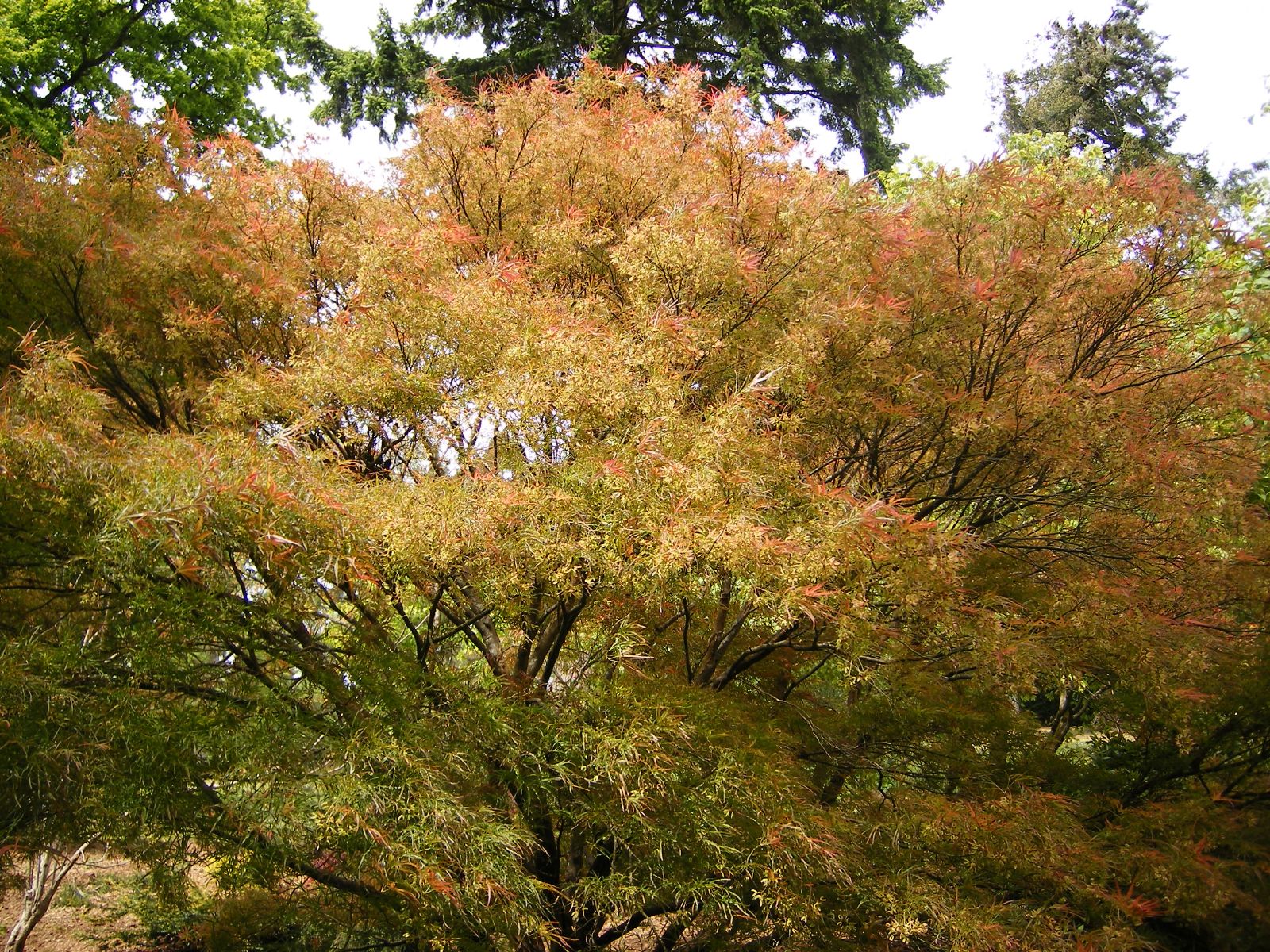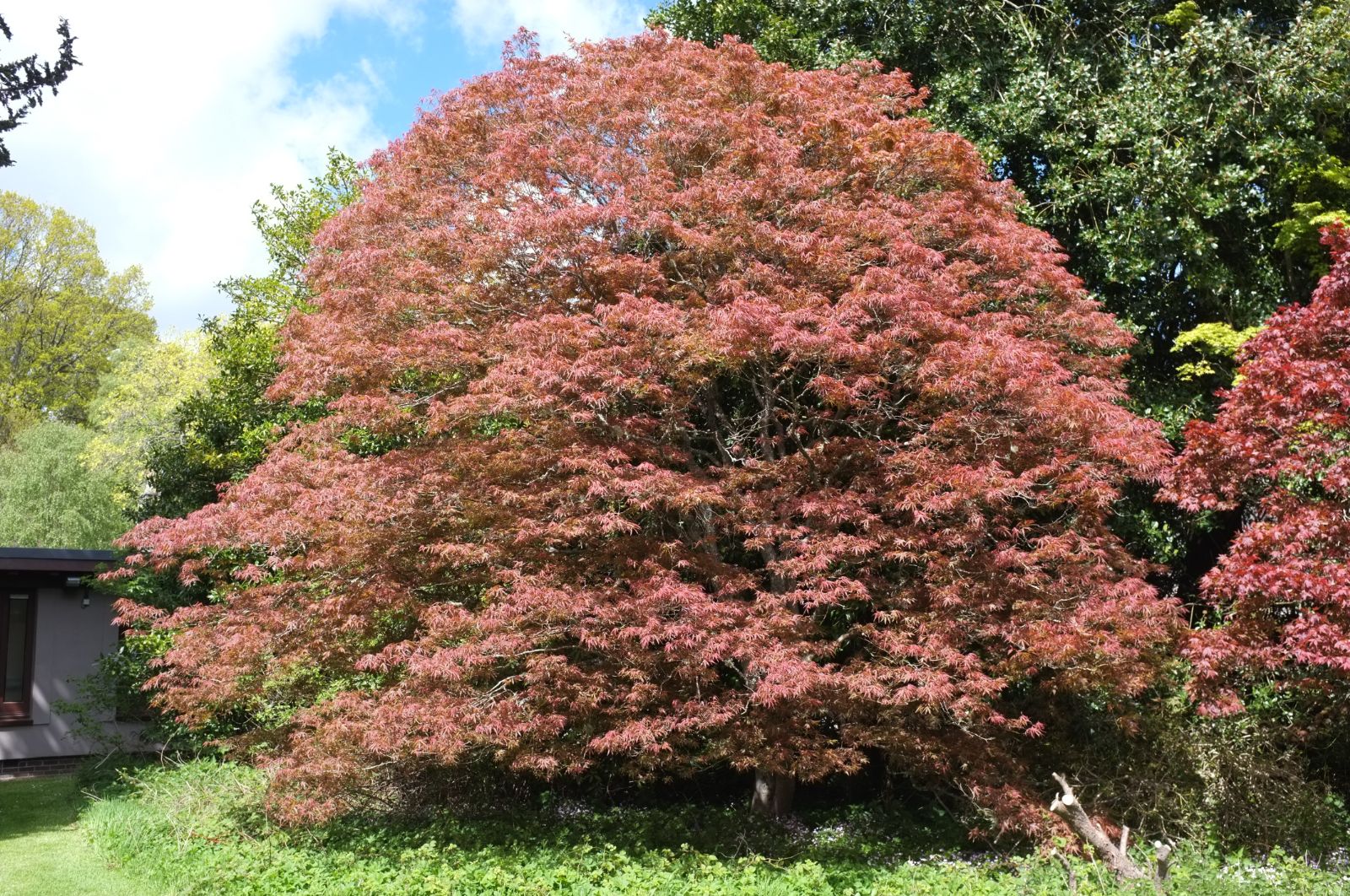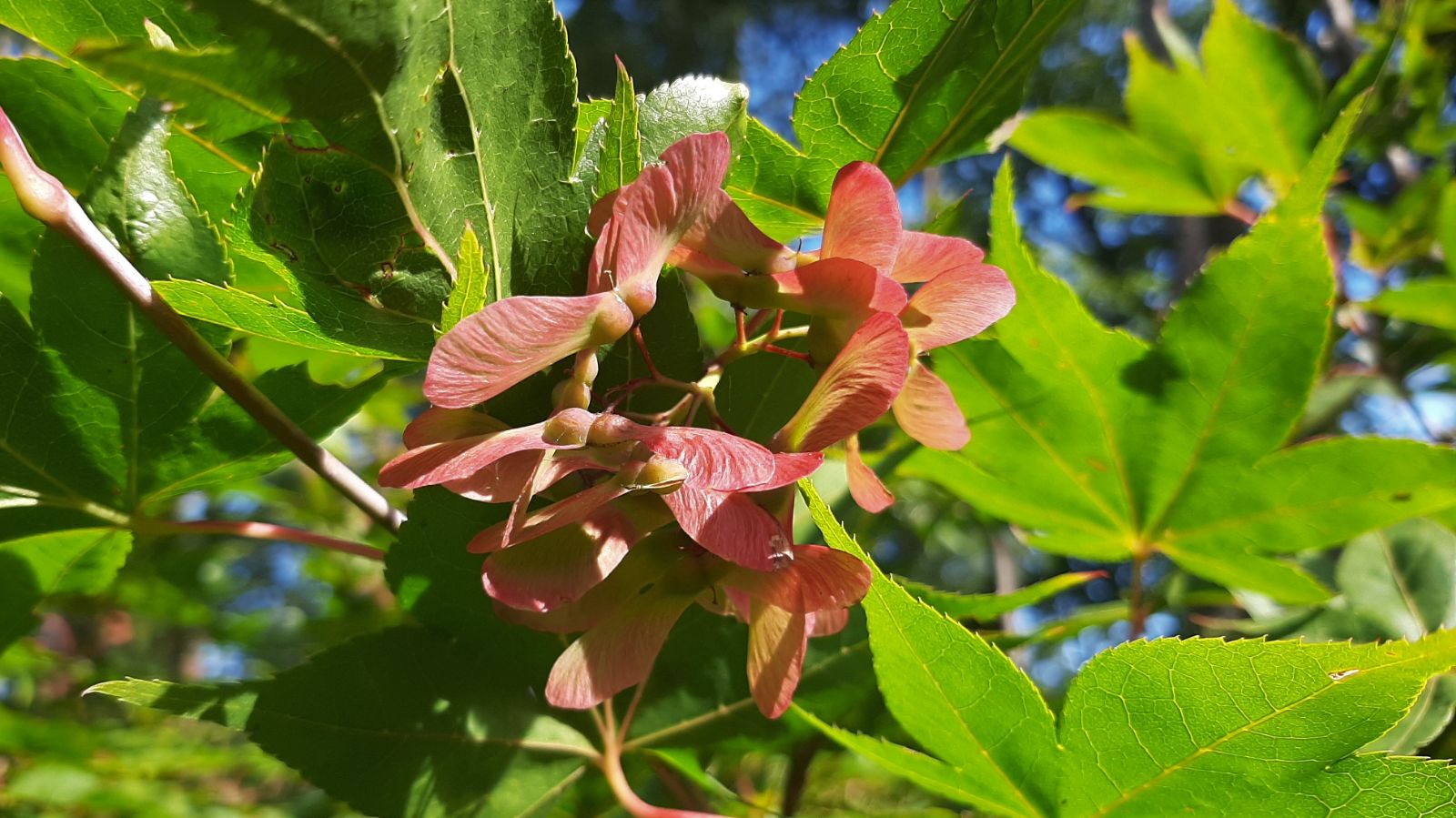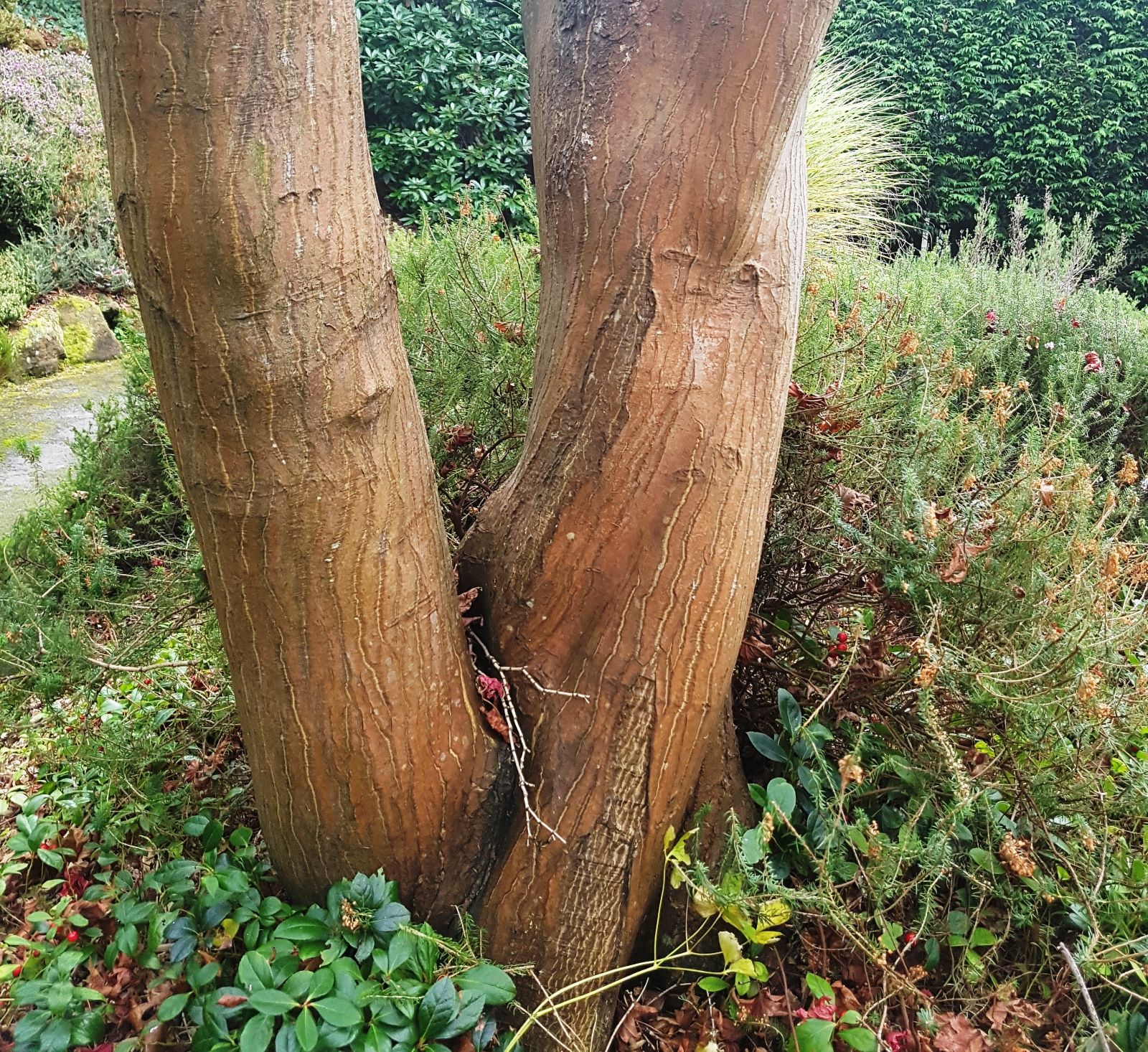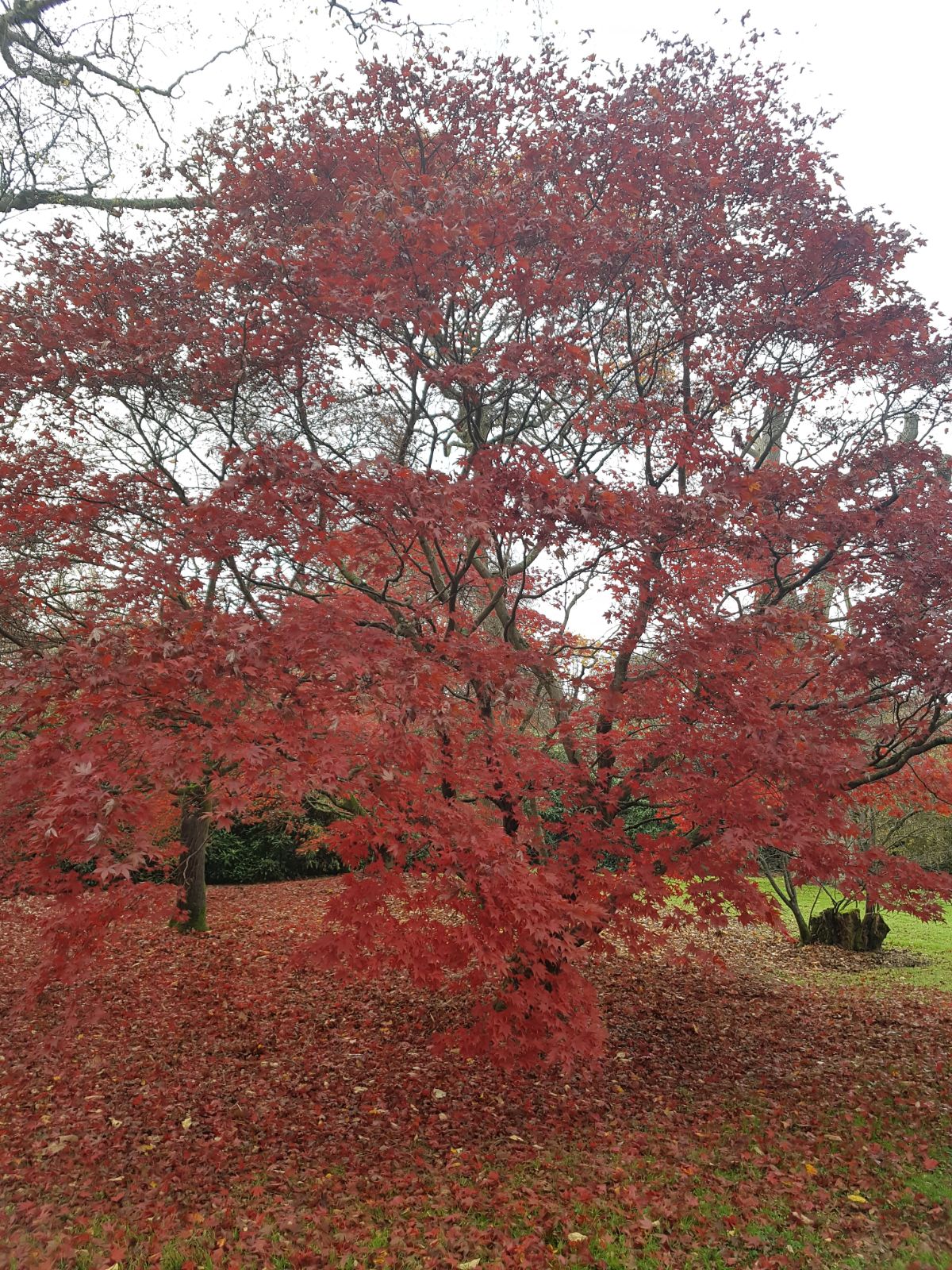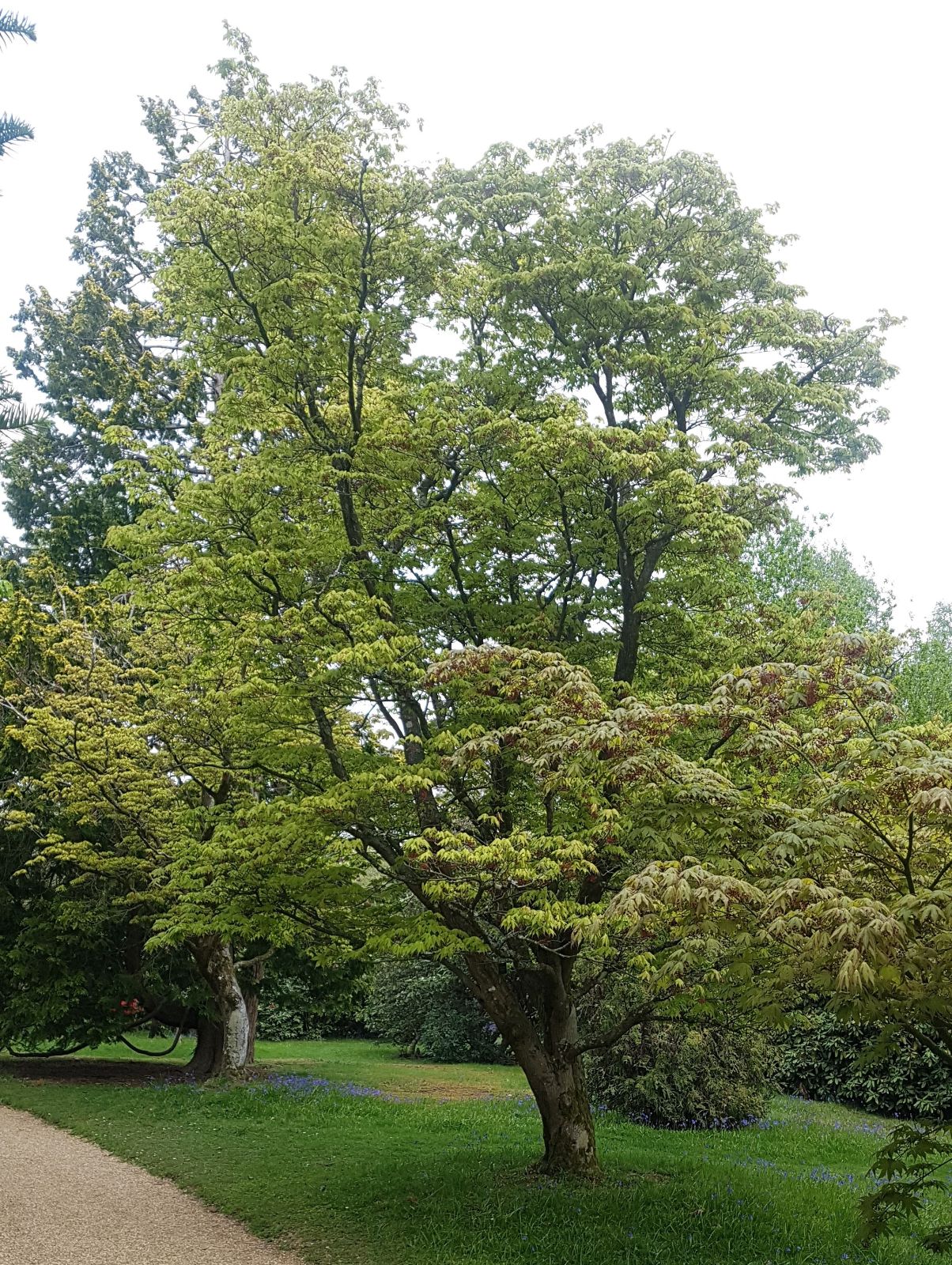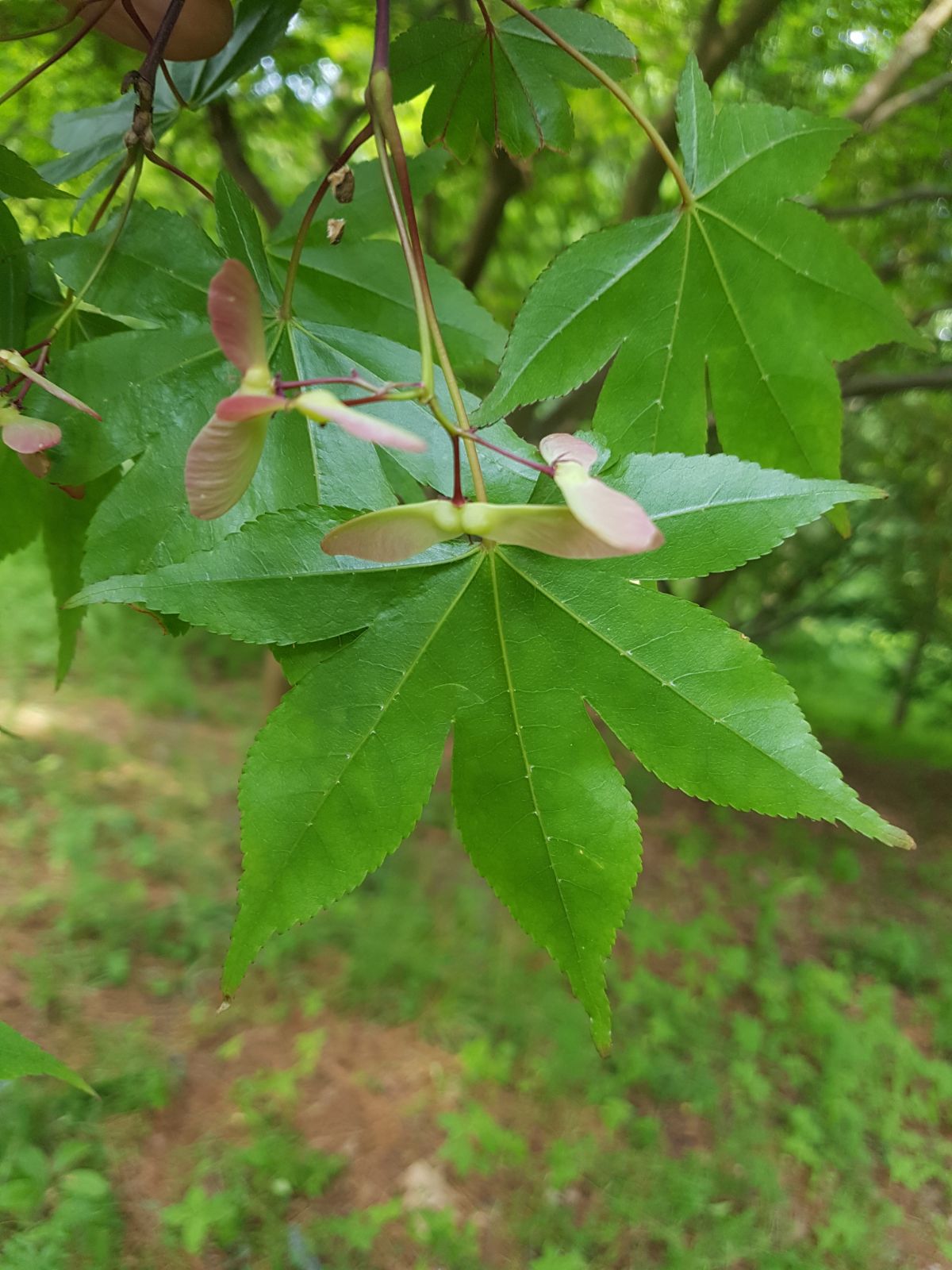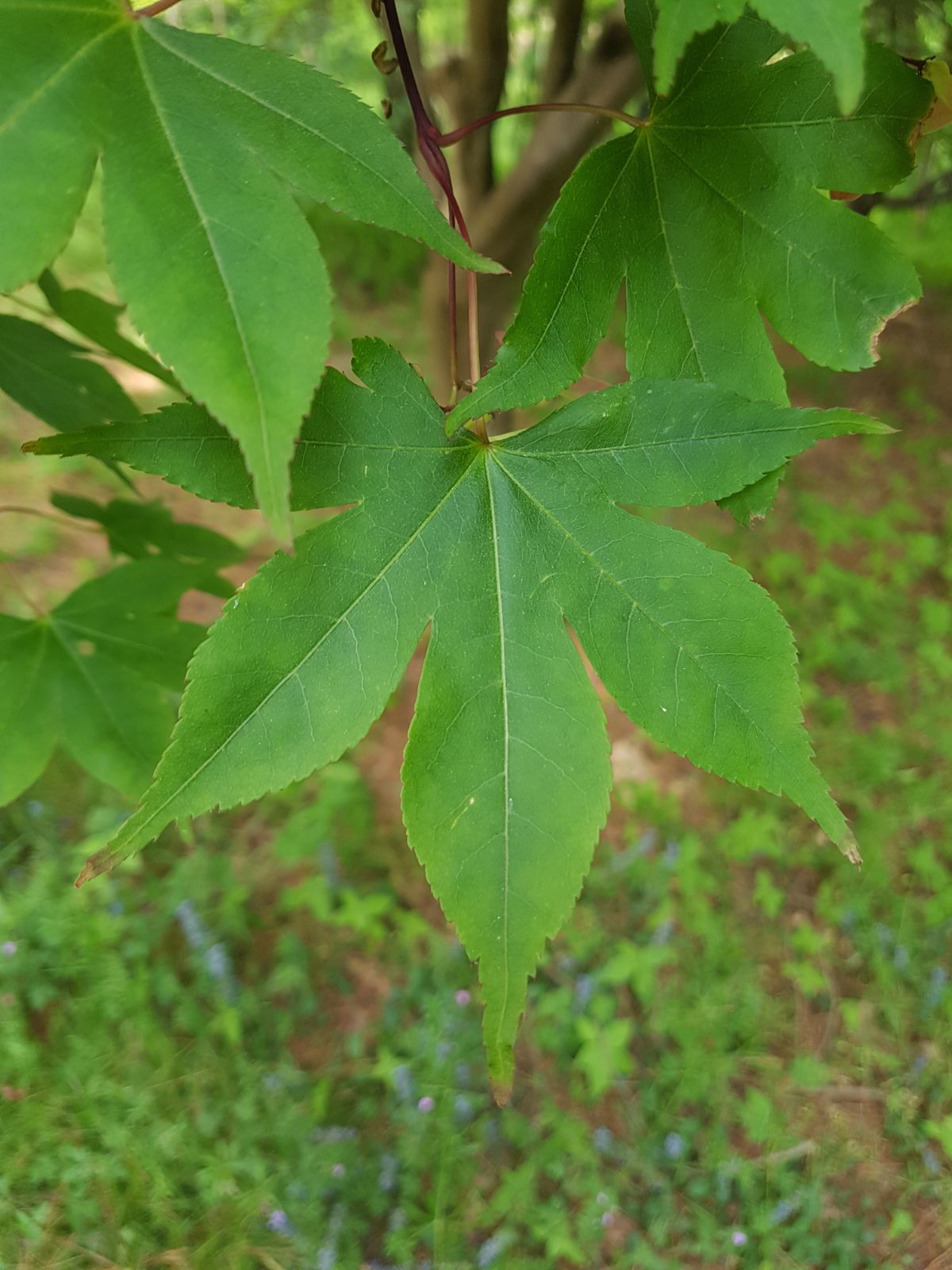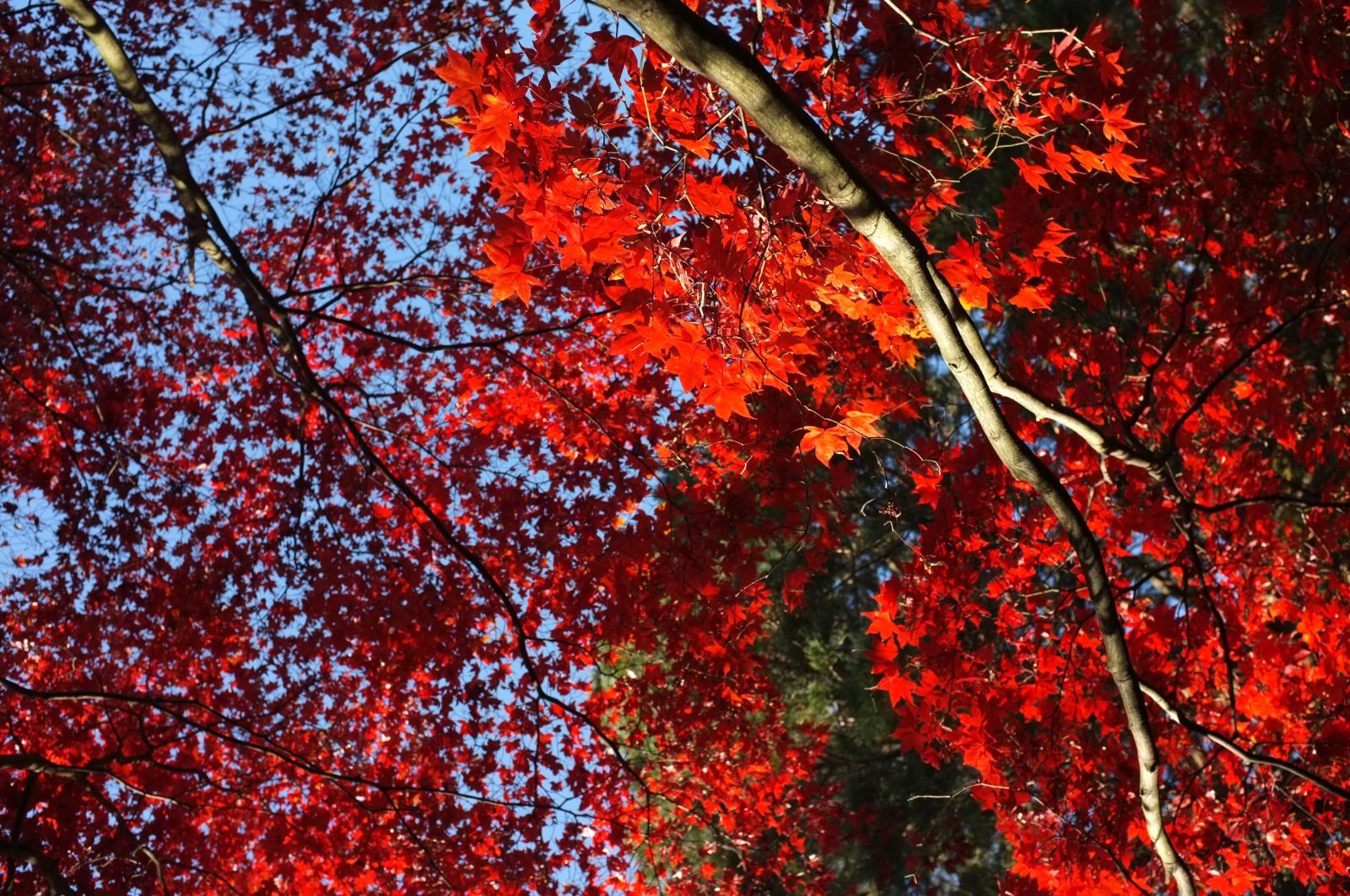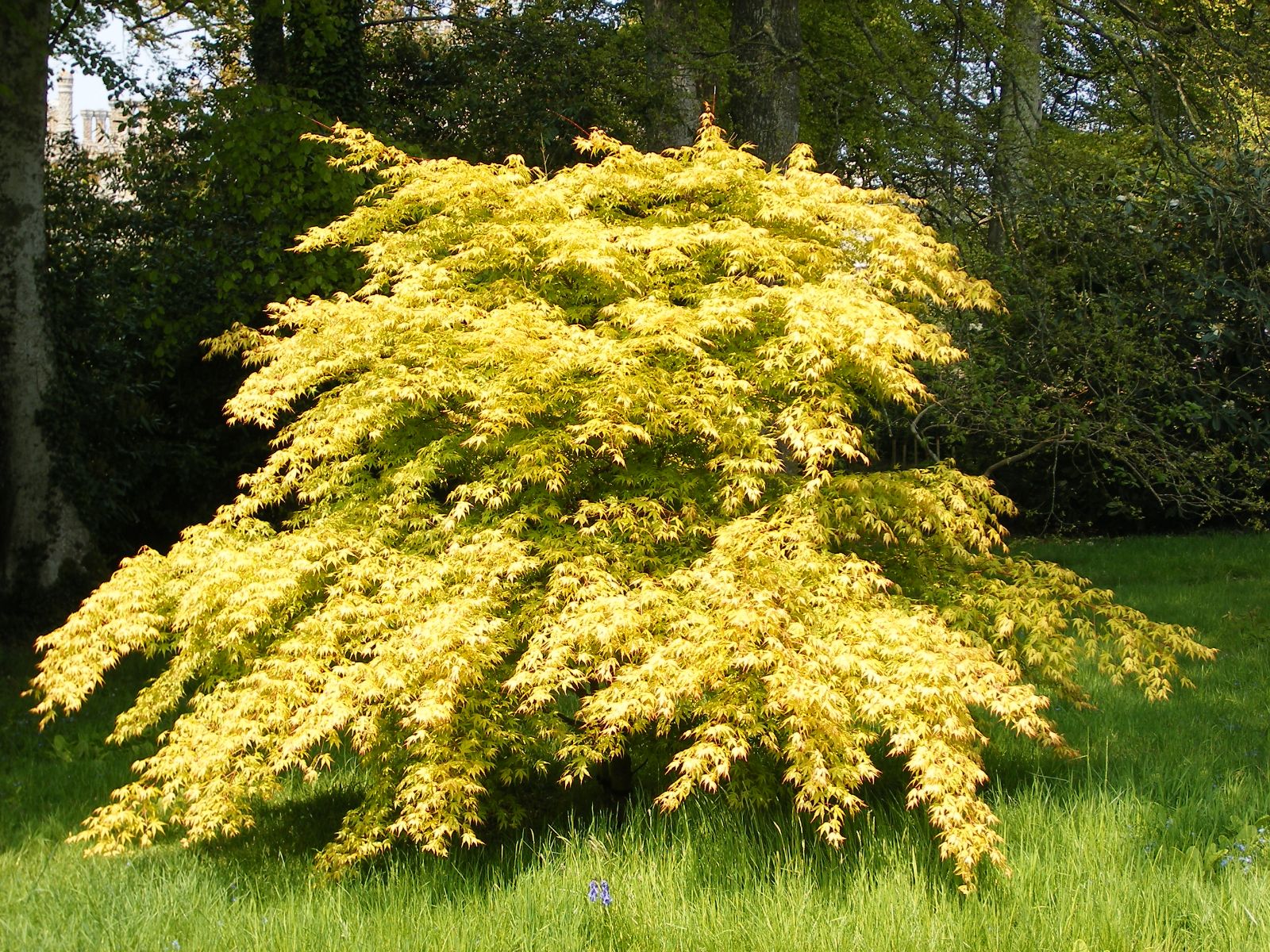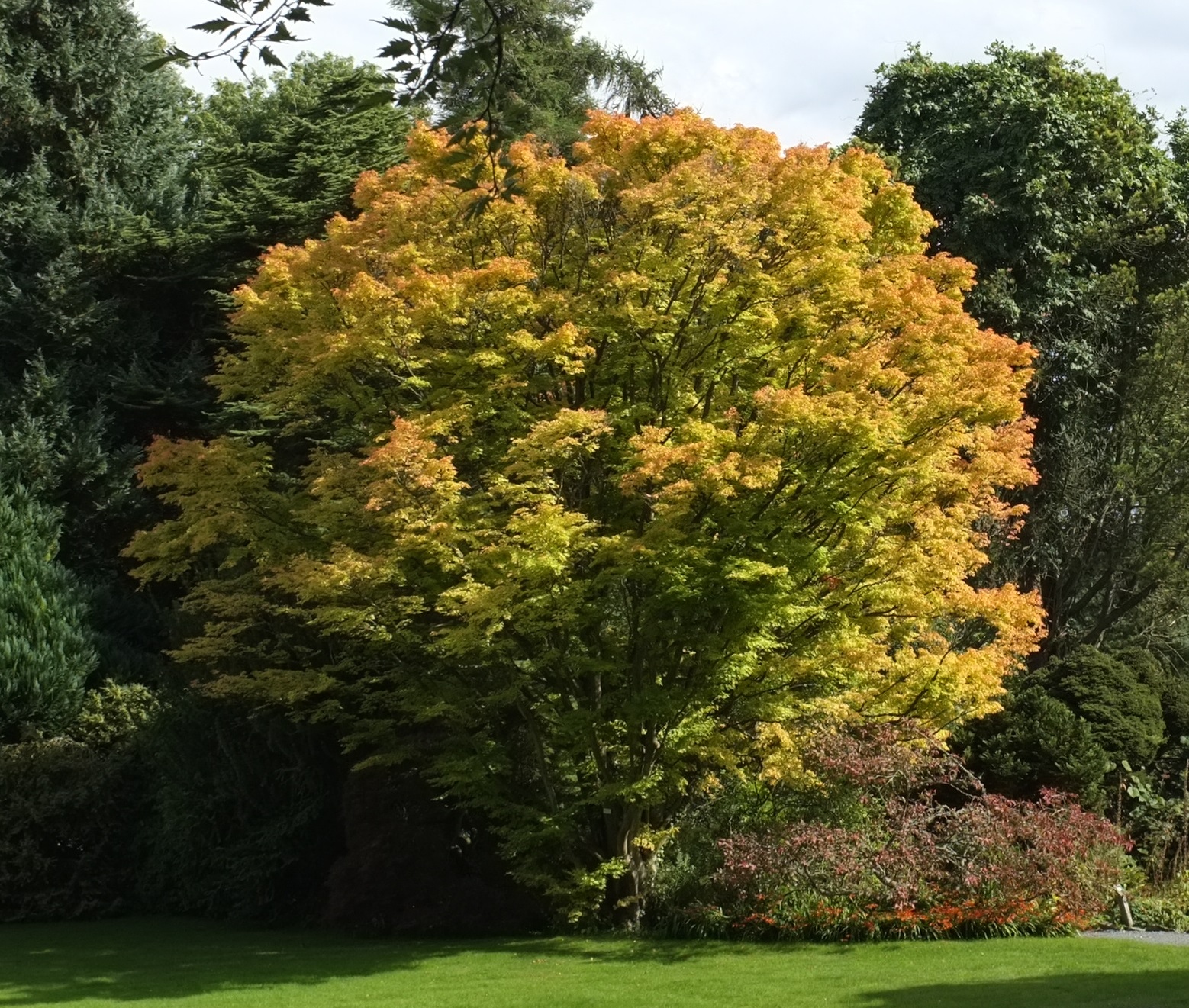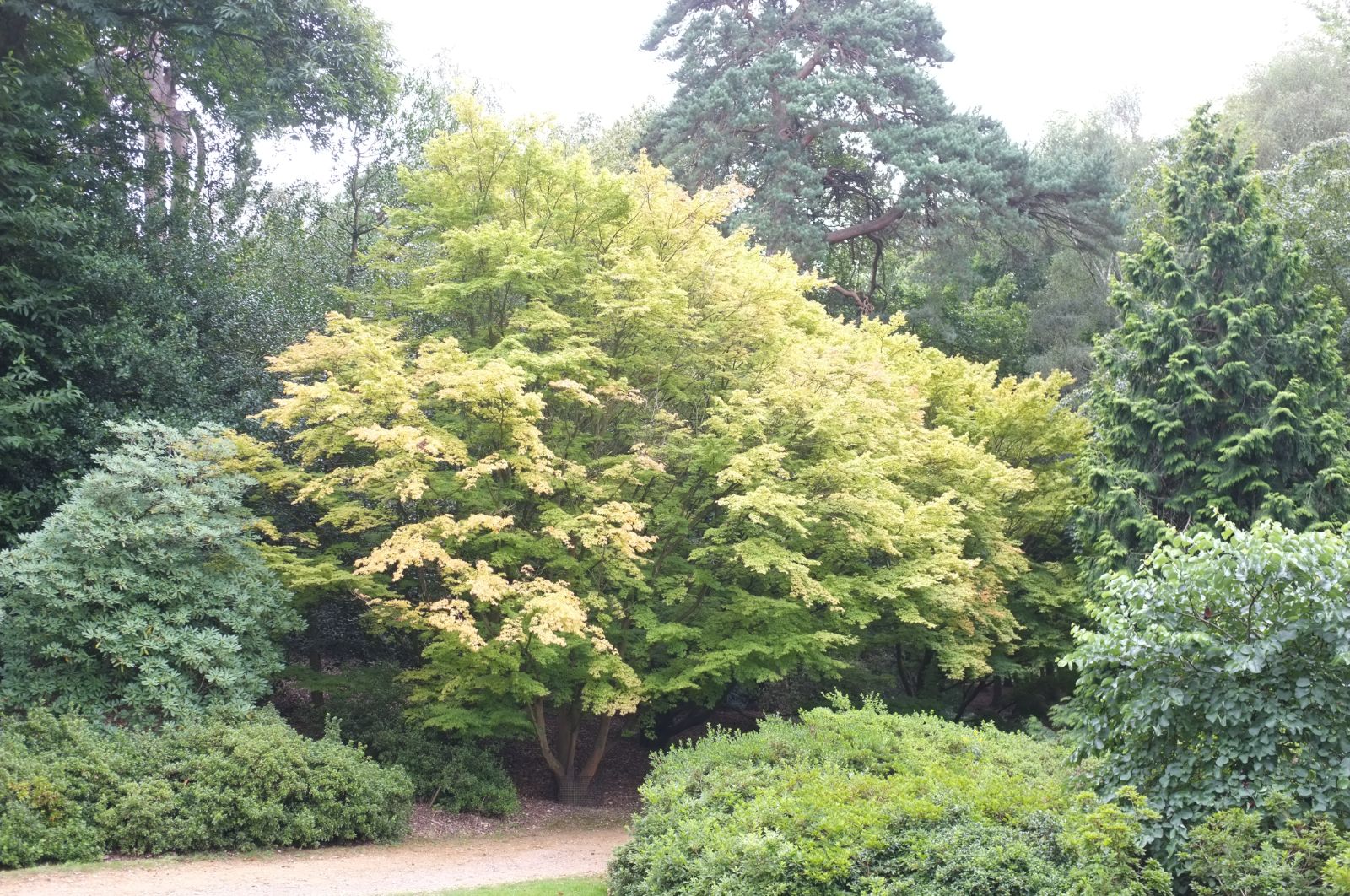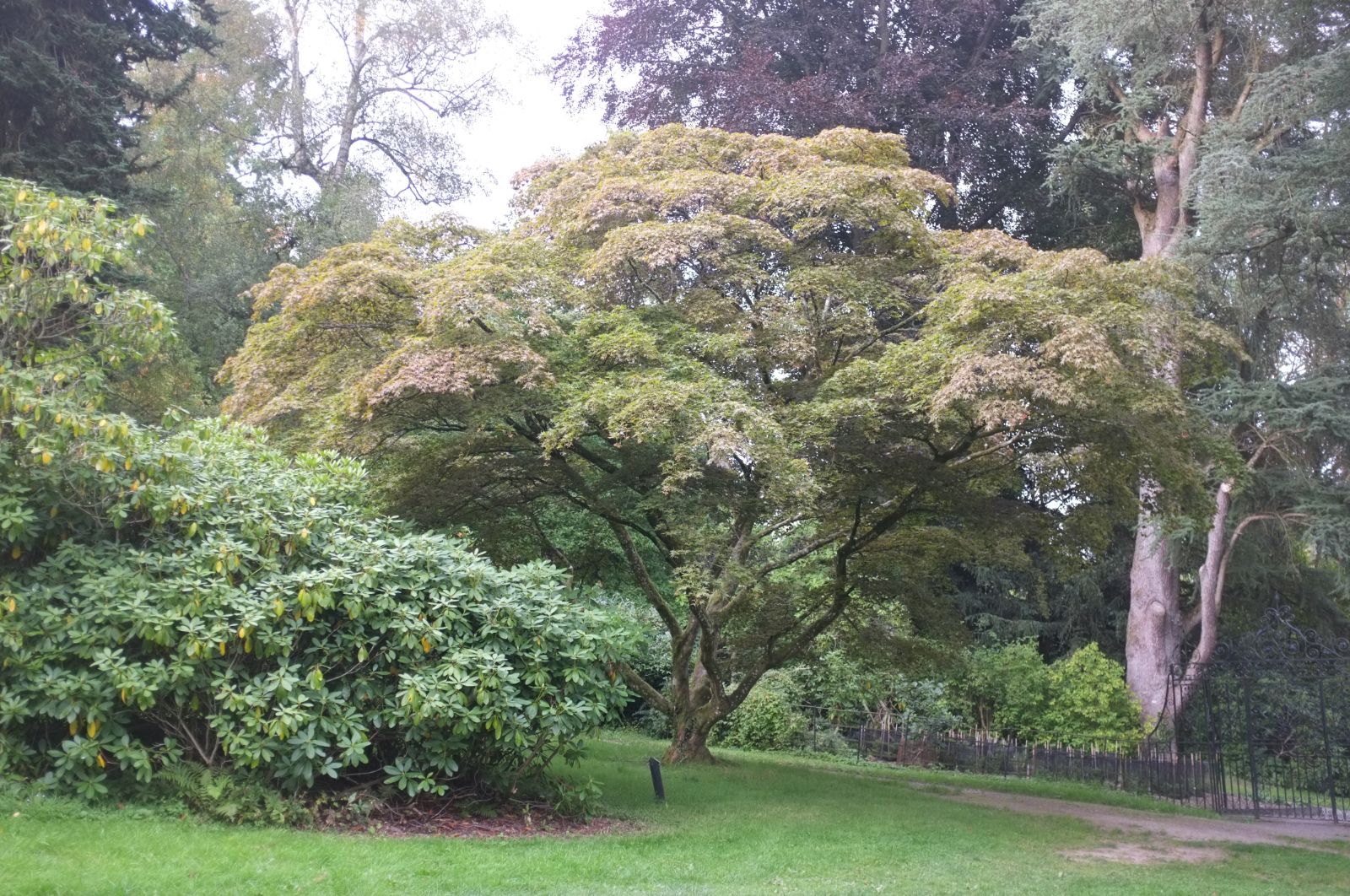Acer palmatum
Credits
Article from Bean's Trees and Shrubs Hardy in the British Isles
Article from New Trees by John Grimshaw & Ross Bayton
Recommended citation
'Acer palmatum' from the website Trees and Shrubs Online (treesandshrubsonline.
Genus
- Acer
- Sect. Palmata, Ser. Palmata
Synonyms
- A. polymorphum Sieb. & Zucc.
Infraspecifics
Other taxa in genus
- Acer acuminatum
- Acer amplum
- Acer argutum
- Acer barbinerve
- Acer buergerianum
- Acer caesium
- Acer calcaratum
- Acer campbellii
- Acer campestre
- Acer 'Candy Stripe'
- Acer capillipes
- Acer cappadocicum
- Acer carpinifolium
- Acer 'Cascade'
- Acer caudatum
- Acer ceriferum
- Acer chapaense
- Acer chienii
- Acer circinatum
- Acer cissifolium
- Acer × conspicuum
- Acer cordatum
- Acer coriaceifolium
- Acer × coriaceum
- Acer crataegifolium
- Acer davidii
- Acer diabolicum
- Acer distylum
- Acer divergens
- Acer duplicatoserratum
- Acer elegantulum
- Acer erianthum
- Acer 'Esk Flamingo'
- Acer fargesii
- Acer fenzelianum
- Acer flabellatum
- Acer forrestii
- Acer franchetii
- Acer × freemanii
- Acer fulvescens
- Acer 'Gimborn'
- Acer ginnala
- Acer glabrum
- Acer 'Gold Coin'
- Acer granatense
- Acer grandidentatum
- Acer griseum
- Acer heldreichii
- Acer henryi
- Acer × hillieri
- Acer hookeri
- Acer hyrcanum
- Acer japonicum
- Acer kawakamii
- Acer komarovii
- Acer laevigatum
- Acer laurinum
- Acer laxiflorum
- Acer lobelii
- Acer longipes
- Acer macrophyllum
- Acer mandshuricum
- Acer maximowiczianum
- Acer maximowiczii
- Acer metcalfii
- Acer miaotaiense
- Acer micranthum
- Acer 'Mindavi'
- Acer 'Minorient'
- Acer miyabei
- Acer miyabei × campestre
- Acer monspessulanum
- Acer morifolium
- Acer 'Mozart'
- Acer oblongum
- Acer obtusifolium
- Acer okamotoanum
- Acer oliverianum
- Acer opalus
- Acer orientale
- Acer papilio
- Acer pauciflorum
- Acer pectinatum
- Acer pensylvanicum
- Acer pentaphyllum
- Acer pentapotamicum
- Acer pictum
- Acer pilosum
- Acer pinnatinervium
- Acer platanoides
- Acer platanoides × amplum
- Acer platanoides × truncatum
- Acer × pseudoheldreichii
- Acer pseudoplatanus
- Acer pseudosieboldianum
- Acer pubinerve
- Acer pycnanthum
- Acer rubescens
- Acer rubrum
- Acer rufinerve
- Acer saccharinum
- Acer saccharum
- Acer sempervirens
- Acer 'Serpentine'
- Acer serrulatum
- Acer shenkanense
- Acer sieboldianum
- Acer sikkimense
- Acer 'Silver Cardinal'
- Acer 'Silver Ghost'
- Acer sinense
- Acer sinopurpurascens
- Acer spicatum
- Acer stachyophyllum
- Acer taronense
- Acer tataricum
- Acer tegmentosum
- Acer tenellum
- Acer tetramerum
- Acer tibetense
- Acer tonkinense
- Acer triflorum
- Acer truncatum
- Acer tschonoskii
- Acer turkestanicum
- Acer tutcheri
- Acer ukurunduense
- Acer velutinum
- Acer wardii
- Acer 'White Tigress'
- Acer wilsonii
- Acer × zoeschense
A deciduous tree of rounded form, rarely seen more than 20 ft high in cultivation, but more than twice as high in a wild state; habit rounded, often wider than high; branchlets glabrous. Leaves palmately five- or seven-lobed, 2 to 31⁄2 in. long and wide; the lobes ovate-lanceolate, cleft two-thirds of the way to the base of the blade, sharply double-toothed, glabrous on both surfaces except in the axils of the ribs beneath; green at first, becoming bronzed or purplish in autumn. Flowers in somewhat erect, glabrous, stalked umbels; small and purple. Fruit glabrous; keys about 1⁄2 in. long; wings 1⁄8 in. wide, much incurved, the pair forming a broad arch.
Native of Japan, whence it was introduced to England in 1820, and also of China and Korea. Having long been cultivated by the Japanese, it has produced an extraordinary number and variety of forms differing in colour and form of leaf. To many of them unwieldy Latin names have been given and all bearing such names have been elaborately classified by botanists. Only those best known in cultivation at the present time are described here. These are listed under what would appear to be the correct clonal name according to the provisions of the International Code of Nomenclature for Cultivated Plants.
From the Supplement (Vol. V)
Even in the wild, A. palmatum is a variable species, in size of the leaves and the depth of their lobing and toothing, as well as in the size of the fruits. Various classifications have been proposed, but none is really of any practical use in horticultural nomenclature.
The number of cultivars of this species now available in Britain is happily much greater than when the first volume of the present edition was published in 1970. Indeed, there are probably more than there have ever been. In some measure at least this renewal of interest in the group is due to the publication in 1978 of J. D. Vertrees’ Japanese Maples, with its meticulous descriptions and excellent colour photographs of the many garden varieties growing in his collection at Roseberg, Oregon.
The following fuller account of the cultivars largely replaces that given on pages 217–19, and owes much to Mr Vertrees’ book.
Palmatum Group
Under this heading are described cultivars whose foliage is of normal shape, regardless of the size of the leaf or whether it is five- or seven-lobed. Thus the group includes those cultivars normally placed under var. heptalobum (septemlobum), which are characterised by their large, seven-lobed leaves. However, there is an exception: in both botanical and horticultural nomenclature, it has been usual to include in var. heptalobum cultivars which are intermediate between its typical state and the Dissectum group. Representative of these is ‘Elegans’, and cultivars with this sort of foliage are treated separately (see Elegans group).
The purple- and bronze-leaved cultivars need full light to develop their colouring, but preferably should have protection from the strongest sun, as they tend to lose their colour in a hot summer if fully exposed. Of those mentioned below, the maples with a more or less purple summer coloration are: ‘Akegarasu’, ‘Atropurpureum’ (selected clones); ‘Bloodgood’; ‘Fireglow’; ‘Moonfire’; ‘Murogawa’; ‘Nuresagi’; ‘Shojo’; ‘Umegae’. Those with a more bronze summer colouring are: ‘Atropurpureum’ (of Wattez); ‘Oshu Beni’ (and ‘Oshio Beni’); ‘Rubrum’; ‘Yezo Nishiki’.
‘Akegarasu’. – Leaves large, to 5 in. wide, shallowly lobed, dark purple red at first but tending to bronze later. It makes a small tree.
‘Aoyagi’. – Stems vivid green. Autumn colour yellow. An interesting contrast to ‘Senkaki’.
‘Atropurpureum’. – As remarked on page 217, this name now covers several clones as well as seedlings. They are of varying merit, but a clone widely distributed in this country is very adequate, greening markedly only in a hot summer and colouring well in autumn. In trials recently held at Boskoop the three star award was restricted to the clone distributed by Messrs Constant Wattez of Woudenberg, in which the foliage is brownish red in summer turning bright red in autumn; this may prove to be the same as ‘Oshio Beni’, for which see below under ‘Oshu Beni’ (Dendroflora, No. 15/16, p. 4 (1979) and op. cit., No. 20, pp. 56, 60 (1982)).
‘Aureum’. – Leaves five-lobed, yellow with a reddish tinge when young, becoming greenish gold, yellow in autumn. A bushy small tree needing a sunny position.
‘Bloodgood’. – A recent selection of the Atropurpureum group, with dark wine-red leaves holding their colour well. Distributed by the Bloodgood Nurseries, Long Island, USA, and now available in Britain from several nurseries, it is propagated by cuttings as well as by grafting. Still more recent is ‘Fireglow’, raised in Italy, which may prove to be superior.
‘Corallinum’. – ‘A charming little variety, quite one of the gems of the series, is that named corallina, rarely seen, as it is difficult to propagate and rarely procurable. This year at Coombe Wood the early spring foliage was exceptionally brilliant, and had at a distance the appearance of an Indian Azalea’ (J. H. Veitch, Journ. R.H.S., Vol.29, p. 343 (1905)). This maple is still very rare, but there is an example in the garden at Jermyns House, Ampfield, Hampshire (see Vertr., p. 120). Unfortunately, the name ‘Corallinum’ is used in Holland for ‘Senkaki’ (‘Sango Kaku’).
Others of the same type as ‘Corallinum’ are ‘Chishio’, though this eventually attains 6 ft or more; and ‘Seigen’. Both of these were distributed in Britain earlier this century and could probably be found in old collections. They are described by Vertrees on pp. 119 and 128.
‘Hogyoku’. – Leaves rich green, with seven shallow lobes, of firm texture, turning orange in autumn. Bushy habit (Vertr. p. 50).
‘Ki Hachijo’. – Leaves with mostly nine, deeply toothed, lobes, turning yellow flushed with rose in autumn, finally orange and red.
’ Kiyohime’. – Leaves under 2 in. long and wide, deep green, edged and shaded reddish orange when young, yellow-orange in autumn. A small bush (Vertr., p. 98).
‘Koreanum’. – Leaves thin, up to about 3 in. long and wide, five- or seven-lobed half or two-thirds of the way to the centre, the lobes with long, slender tips, fairly deeply and closely toothed, on slender pedicels up to 2 in. long. A cultivar of slender, upright habit distributed by Messrs Marchant in the 1930s, remarkable for the startling autumn colour of intense dark scarlet. It is possible that some plants now sold as ‘Koreanum’ are seedlings, but those seen colour quite well in autumn. Although ‘Koreanum’ may well have come from Korea via Japan, it is a cultivar and has nothing to do with var. coreanum Nakai, which is a very minor variant of A. palmatum.
‘Lutescens’. – A bushy tree attaining a height of 20 ft in 25 years, with seven-lobed leaves up to 41⁄2 in. wide, of firm texture, medium green, turning brilliant yellow or orange in autumn. Raised by Messrs Hillier and also known as ‘Heptalobum Lutescens’.
‘Moonfire’. – Leaves with mostly seven lobes reaching almost to the centre, long-tapered, dark purplish red with a bluish sheen, holding their colour well and turning crimson in autumn. Raised in the USA (Vertr., p. 52).
‘Murogawa’. – Leaves large, seven-lobed, orange-red or crimson in autumn (Vertr. p. 52). ‘Nuresagi’ (Vertr., p. 54) is similar. Both make small trees.
‘O Kagami’. – Leaves blackish red for most of the summer, red and scarlet in autumn, fan-shaped, up to 41⁄4 in. long and wide. An upright small tree (Vertr., p. 54).
‘Osakazuki’. – This is unfortunately a confused name, which has been used for at least two clones, and possibly for seedlings. What is believed to be the form originally introduced to this country has seven-lobed leaves of firm texture, up to 4 in. long and 6 in. wide, the lobes sharply toothed to one-half of the distance to the centre or slightly more, the basal lobes backward-pointing. It is a bushy shrub or small tree, remarkable for the brilliance of its uniform, red autumn colouring. But other plants under the name have thinner, more deeply lobed leaves and less remarkable colouring. The confusion is an old one, since W. J. Mitchell, then the Curator of the Westonbirt collection, remarked in an article published in 1933 that recently imported plants were different from the form originally received under the name. It must be said that the second form mentioned above agrees better than the first with the description given by the Japanese botanist Koidzumi in 1911, but ‘Osakazuki’ is a cultivar name, which had appeared in catalogues long before that.
‘Oshu Beni’. – Leaves 2 to 3 in. long and wide, deeply divided into seven oblong-ovate or lanceolate lobes, which are scarcely toothed except near the tip. Their colour is at first red, becoming bronze, then bright red in autumn. This small tree has been in commerce in Britain under its Japanese name since the 1930s. Vertrees remarks that this is not the same as the maple marketed in the USA under the similar name ‘Oshio Beni’. This too has bronze summer colouring but makes a taller tree with leaves 3 to 4 in. wide, with broad-ovate serrated lobes. See also the remark under ‘Atropurpureum’ above.
‘Rubrum’. – Leaves seven-lobed, fairly deeply so, 4 to 5 in. long and wide, bright red at first, darkening to maroon-red, crimson in autumn. According to von Schwerin, who published the name in 1898 (as A. p. var. thunbergii subvar. euseptemlobum f. rubrum), this maple was also known in the trade as A. p. septemlobum purpureum. There has been confusion between it and ‘Sanguineum’.
‘Saku’ (‘Shigarami’). – Leaves with seven long, radiating lobes, at first suffused with purple at the edge. Autumn colour yellow, orange and red (Vertr., p. 58). ‘Tana’ is similar (Vertr., p. 59).
‘Samidare’. – Leaves large, with seven finely toothed lobes, of firm texture, reddish at the edge, turning yellow edged purple or crimson in the autumn.
‘Sanguineum’. – This is a confused name, possibly through the epithet sanguineum having been applied to two Siebold introductions early in the 1860s. But the maple he himself listed as A. p. sanguineum is the one figured in Illustration Horticole Vol. 14, t.526 (1867); this had five-lobed, blood-red leaves, later green, while the A. p. sanguineum of Carrière (Rev. Hort., 1867, p. 280) is probably ‘Rubrum’ (see above), as too was the maple listed under this name by Nicholson.
‘Sazanami’. – Leaves under 2 in. long and wide, seven-lobed, orange-red when young, gold in autumn. Compact bushy habit (Vertr., p. 83).
‘Senkaki’. – See Volume I, page 219. Although ‘Senkaki’ and ‘Sango Kaku’ are said to be alternative names for the same cultivar, plants imported from Holland under the latter name have twigs of a much more intense red than in the clone long grown in this country as ‘Senkaki’ (or A.p. cinnabarinum), though they appear to be the same in other respects. The cultivar name ‘Corallinum’ has been applied in Dutch literature to the red-twigged maple, but properly belongs to a quite different maple (see above).
‘Shojo’. – Leaves dark purplish red, five-lobed almost to the centre, finely toothed, holding their colour well and becoming crimson in autumn.
‘Tatsuta’ (‘Tatsuta Gawa’). – An old Japanese cultivar, making an elegant small tree and notable for its brilliant scarlet autumn colour.
‘Tsuma Beni’. – Leaves at first purple at the edge and at the tips of the lobes, red in autumn. Bushy habit (Vertr., p. 60). ‘Tsuma Gaki’ (Vertr., p. 61) is similar.
‘Ukon’. – Young leaves yellow, later bright green with some yellow mottling, mostly yellow in autumn. Bushy habit.
‘Umegae’. – Leaves about 2 in. long and wide, deeply seven-lobed, red when young, purplish red through most of the summer, crimson in autumn. It makes a small, upright shrub (Vertr., p. 61).
‘Utsu Semi’. – Notable mainly for its distinctive foliage, the main lobes being unusually broad and the whole leaf about 4 in. wide. The leaves turn crimson and purple in autumn. A small tree (Vertr., p. 62).
‘Yezo Nishiki’. – Leaves with seven long-tapered lobes reaching about halfway to the centre, bright reddish purple at first, bronzing in summer, red in autumn. A small tree (Vertr., p. 62).
Elegans Group
Leaves mostly seven-lobed, divided to the base or near it, the lobes lanceolate above the cuneate base, toothed or somewhat incised, broader and not so much cut as in the Dissectum group, from which these maples also differ in being of erect habit. In the old system of nomenclature the maples known in Europe at that time were placed under ‘var. septemlobum’.
‘Beni Kagami’. – Leaves dark red when young, greening later and becoming brilliant red in autumn. A vigorous shrub to some 20 ft high and wide (Vertr., p. 76).
‘Burgundy Lace’. – Leaves at first wine-red, becoming green or bronzy by late summer. It makes a small tree. Raised in the USA before 1958. ‘Sherwood Flame’, raised later (also in the USA) is very similar to this but reported to be an improvement (Vertr., p. 76).
‘Chitoseyama’. – The true cultivar of this name is portrayed and described by Vertrees, p. 77. Some plants distributed under this name derive from those cultivated at Exbury and are clearly different. The Exbury clone has seven-lobed, bronze-green leaves turning orange in the autumn, but the true clone, which is also available, has bright red leaves of the Elegans type, light crimson when young, later purple-red, scarlet in autumn.
‘Elegans’. – The type of the group, this has green leaves (yellowish at first), with rather widely spreading lobes. It makes a small sturdy tree and colours orange in the autumn. It was named by Nicholson in 1881 as A. p. septemlobum elegans, but its history is unknown (Vertr., p. 77).
‘Hessei’ (‘Elegans Purpureum’). – A vigorous shrub whose leaves are purplish crimson at first, becoming bronze by late summer and red in autumn. In cultivation since the end of the last century (Vertr., p. 77).
’ Katsura’. – Young foliage pale orange-yellow with deeper coloured margins, later green, then yellow and orange in autumn. Leaves closely set, about 11⁄4 in. long and wide but somewhat larger on strong growths. Of comparatively dwarf habit, to about 4 ft (Vertr., p. 98).
‘Kinran’. – Leaves at first purple-red with green veining, becoming green shaded dark red in late summer and a fine crimson in autumn (Vertr., p. 79). It makes a large, round-topped bush, while the otherwise similar ‘Matsukaze’ is wide-spreading and somewhat pendulous (Vertr., p. 80). This too gives brilliant autumn colour.
‘Nicholsonii’. – Leaves purplish red at first, with forward-pointing, narrowly tapered central lobes, turning brilliant crimson in autumn. Its original trade name was A. p. digitatum purpureum and it was renamed f. nicholsonii by Graf von Schwerin in 1893, in honour of the then Curator of Kew.
‘Omurayama’. – A cultivar with the habit of a weeping willow when grown on a trunk. Leaves green with closely set lobes, colouring gold and red before falling (Vertr., pp. 75, 82). At present scarcely known in Britain, but obviously very desirable. It attains 15 ft in height and width. Another cascading cultivar in the Elegans group is ‘Oshu Shidare’, but this has purple leaves, crimson in autumn (Vertr., p. 83).
‘Rufescens’. – The true clone, distributed from Veitch’s Coombe Wood nursery, is of the Elegans type, with a reddish tinge to the leaves.
‘Shinonome’. – Leaves orange-red when young, later green flushed red. Open, spreading habit (Vertr., p. 84).
‘Sumingashi’. – Leaves with finely tapered spreading lobes, deep purplish or maroon red, greening or bronzing in late summer, crimson in autumn. A vigorous small tree (Vertr., p. 84).
‘Trompenburg’. – Leaves with seven widely radiating lobes which are revolute at the margin, deep purplish red until late summer, then bronzing and becoming crimson in autumn. A strong growing maple likely to attain 15 ft in height, raised at the Trompenburg Arboretum, Rotterdam (Vertr., p. 86).
Dissectum Group
See Volume I, pages 217–18. To this general discussion it should be added that the cultivar name ‘Dissectum’ or ‘Dissectum Viride’ can hardly now be regarded as any one particular clone.
‘Crimson Queen’. – Leaves deep red, holding their colour well even in sun. Vigorous, eventually 10 ft high. Raised in the USA (Vertr., p. 65). ‘Brocade’ has leaves of a softer red, bronzing in summer, red and orange in autumn.
‘Dissectum Atropurpureum’. – Mr Vertrees remarks that this name cannot be regarded as clonal, since the plants have been largely raised from seed. Outstanding seedlings may, however, have been propagated vegetatively.
‘Dissectum Flavescens’. – Leaves of the Dissectum group but not so finely cut as most, yellowish green becoming yellow in autumn.
‘Dissectum Roseomarginatum’. – Leaves edged with red when young. Following Nicholson’s treatment of 1881, it was stated that this is the same as the form named A. p. Friderici-Guilelmi, but wrongly so; it is an alternative name for ‘Dissectum Variegatum’.
‘Dissectum Variegatum’. – Leaves splashed with white or pink. It was first described by Carrière in 1867 as A. p. Friderici-Guilelmi, but this name has never been much used.
‘Filigree’. – Leaves very finely dissected, light green in spring, becoming darker with a faint pale yellowish speckling, gold in autumn. Of American origin (Vertr., p. 67).
‘Garnet’ (‘Dissectum Garnet’). – Lobes seven, rather coarsely cut, brownish red throughout the season (though not in shade). Vigorous. This was selected by the Dutch firm of Guldemond & Co and put into commerce in 1960.
‘Ornatum’ (‘Dissectum Ornatum’). – Leaves with finely cut lobes, bronzy red when young, eventually becoming green, then red in autumn. Described by Carrière in 1867 from plants exhibited in Paris by the Belgian nurseryman Verschaeffelt (Rev. Hort., 1867, pp. 300 and 391).
‘Seiryu’. – This maple has leaves characteristic of the Dissectum group but is unusual in being of erect habit, eventually 10 to 15 ft high. The leaves are bright green, turning yellow tinged with red in autumn. A cultivar of great promise.
Linearilobum Group
In this small group the leaf is divided almost to the base into five or seven narrow lobes, which are finely toothed but not cut. In the typical cultivar the leaves are green, but the name ‘Linearilobum’ is not clonal, as there are several slightly differing forms under it and also one wrongly named ‘Scolopendrifolium’ (the variant to which this epithet was applied was quite different). Others in this group are:
‘Crippsii’. – Leaves red when young, later brownish red, cut into very fine segments. A seedling raised by Messrs Cripps which received an Award of Merit in 1903 under the name A. palmatum linearilobum purpureum gracile Crippsii – ‘a sad burden’ the committee remarked. It is a weak grower.
‘Linearilobum Atropurpureum’ (‘Atrolineare’). – Leaves of the characteristic form, dark reddish purple, bronzing later. It makes an erect shrub (Vertr., p. 89).
‘Red Pygmy’. – A very slow-growing selection of mound-like habit with brownish red leaves cut into mostly seven slender, almost entire segments up to some 31⁄2 in. long. Put into commerce by Messrs Esveld of Holland; the original plant grew in an Italian garden (Dendroflora No. 6, p. 32). It is beautifully portrayed by Vertrees in a plate facing p. 1.
‘Villa Taranto’. – Similar in habit to ‘Red Pygmy’, eventually attaining about 10 ft in height. Leaves with slender, toothed lobes, some leaves green, other pale brownish red. Propagated from a plant at the Villa Taranto, Lake Maggiore (Vertr., p. 93).
Variegated Cultivars
‘Butterfly’ (‘Kocho Nishiki’, ‘Kocho No Mai’). – Leaves pale green, shaped more or less as in the Elegans group, variable in size, irregularly edged with cream. Twigs very slender. Of dense habit, attaining a large size (Vertr., p. 106).
‘Higasayama’. – Leaves divided into seven deeply and coarsely toothed, elongated and long-tapered lobes, the margins white interrupted by green bands along most of the lateral veins. An old cultivar, sometimes wrongly known as ‘Roseomarginatum’ (the white edging is pink-tinged when the leaves are young). For the true ‘Roseomarginatum’ see ‘Kagiri Nishiki’ (Vertr., p. 108).
‘Kagero’. – Leaves with seven oblanceolate to obovate acuminate lobes, the basal pair backward-pointing, very irregularly variegated with yellow. Upright growth (Vertr., p. 110).
‘Kagiri Nishiki’ (‘Roseomarginatum’). – Leaves five-lobed, the lobes rather distorted, irregularly but finely toothed, sea-green with a pink-flushed margin of varying width, which becomes creamy white later in the season. Upright, open habit (Vertr., p. 110). An old cultivar, known in Europe since the 1880s. ‘Matsugae’ is similar, but the lobes are more deeply notched, and it makes a more vigorous plant (Vertr., p. 114).
‘Orido Nishiki’. – Leaves with five or seven long-tapered, doubled-toothed, rather narrow lobes, deep glossy green, with a very irregular white variegation which sometimes takes up most of the leaf. Young foliage predominantly pink (Vertr., p. 115). ‘Asahi Zuru’ has a similar variegation but the leaves have five wider, less tapered, simply toothed lobes (Vertr., p. 104). Both are vigorous, making large bushes or small trees. With brighter pink young foliage than either of these is ‘Karasugawa’, but this is a less strong grower; its leaves are deeply divided into five notched lobes (Vertr., p. 111). All three need shelter from strong sun, the last especially so.
‘Shigitatsu Sawa’ (‘Reticulatum’). – Leaves mostly seven-lobed, not deeply divided, the veins green, the interspaces yellowish green. Introduced by Siebold in the 1860s. Not a strong grower (Vertr., p. 116).
‘Ukigumo’. – Leaves deeply lobed, about 2 in. wide, with a blended variegation of white and green. Slow-growing to about 6 ft (Vertr., p. 117).
‘Versicolor’. – Leaves mostly seven-lobed, splashed with white, pink-tinged markings of various sizes. Introduced by Siebold about 1860. It has also been known as A. p. septemlobum variegatum, A. p. roseomaculatum and A. p. Aokii. It is inclined to revert.
Miscellaneous Cultivars
‘Hagoromo’ (‘Sessilifolium’). – Leaves almost sessile, closely set on the twigs, five-lobed to the base, the lobes deeply incised, 2 in. or slightly more long, half as wide. Each leaf appears to be a cluster of simple leaves. (A. sessilifolium (Sieb. & Zucc., A. p. f. sessilifolium (Sieb & Zucc.) Rehd.). ‘Hagoromo’ is usually given as the Japanese name for ‘Sessilifolium’, but there is another clone –
‘Koshimino’ – which is identical, according to Vertrees, except in being much more vigorous, the true ‘Hagoromo’ being dwarf. The trees at Westonbirt, which have attained 50 ft in height, must then be ‘Koshimino’. The botanical name A. p. f. sessilifolium is applicable to both.
‘Okushimo’ (‘Crispum’). – Leaves with lobes which are uprolled at the edge, so almost tubular in form. Of steeply fastigiate habit and colouring yellow and orange in the autumn (A. p. f. crispum André; A. involutum Hort.).
‘Shishigashira’ (‘Ribesifolium’). – Leaves to about 2 in. long and wide, dark green, five-lobed, deeply incised, often folded upward along the midrib. Owing to the shortness of the twigs and internodes, the foliage occurs in bunches. Habit fastigiate. A very picturesque maple for a special position. Wrongly known as ‘Cristatum’ or ‘Crispum’ on the continent.
From New Trees
Acer palmatum Thunb.
(Sect. Palmata, Ser. Palmata)
Smooth Japanese Maple
This well-loved species was described by Bean (B217, S50) and Krüssmann (K87), and is given extensive coverage in all works that deal with maples. Over the years its variation has caused a great deal of confusion to both botanists and gardeners, but the situation has now been clarified by the recognition of three subspecies. Familiar cultivars are derived from all three, having been selected for centuries in Japan before being further developed in modern horticulture. The key below is provided as a guide to unfamiliar nomenclature and to enable the attribution of wild-origin material to its correct subspecies. Wild-collected material of any of the three is very scarce in cultivation – unfortunately, as it would be interesting to see the true natural variation present in these trees. Intermediates occur in the wild and have been named by Japanese botanists (P. Gregory, pers. comm. 2007).
| 1a. | Leaves 5–10 cm long, with seven (to nine) lobes, divided more than three-quarters to the base, margins coarsely toothed; Japan | subsp. matsumurae Koidz. |
| 1b. | Leaves with five to seven lobes, divided to about half the diameter of the leaf | 2 |
| 2a. | Tree or shrub to 10 m tall, usually taller than wide; leaves 5–10(–15) cm long, with five to seven lobes, divided up to two-thirds to the base, margins very finely serrate; samaras 3–5 cm long; China, Japan, Korea | subsp. amoenum (Carrière) Hara |
| 2b. | Tree or shrub to 10 m tall, usually wider than tall; leaves 4–6 cm long, 5–10 cm across, with five to seven lobes, divided two-thirds to three-quarters to the base, margins coarsely double-serrate; samaras 1–1.5 cm long; China, Japan, Korea, Taiwan | subsp. palmatum |
'Atropurpureum'
Leaves rich reddish, five-lobed or partly seven-lobed by the development of irregular minor lobes at the base. There may be several clones under this name, but by rights it belongs to the one distributed by Van Houtte’s nursery and illustrated in Flore des Serres, Vol. 12, 1857, t. 1273. Messrs Cripps used to sell seedlings as A. p. purpureum.
'Aureum'
Leaves five-lobed, yellow when young, becoming golden later.
Dissectum Group
This group comprises a number of garden forms with seven, nine or eleven lobes to the leaf, reaching to the leaf-stalk, each lobe being in turn deeply and finely cut and each ultimate division finely toothed. The clones differ somewhat in the fineness of the cutting of the leaf, as well as in its colour. The botanical group-name var. dissectum (Thunb.) Miq., which is founded on a Japanese garden plant described by Thunberg as A. dissectum in 1805, embraces all these clones, whatever their leaf-colouring. The forms with coloured leaves are well enough distinguished, but the naming of the green-leaved clones has become confused. What is generally known as A. p. dissectum or A. p. dissectum viride appears to be the clone distributed by Van Houtte as A. p. palmatifidum, illustrated and described in Flore des Serres, Vol. 21, 1875, t. 2156–7. The form distributed in this country by Messrs Cripps as A. p. palmatifidum was, however, a different clone from this, distinguished by its very finely cut, fern-like foliage. Both the green-leaved clones make mushroom-headed bushes that may reach in time a height of 6 to 8 ft but usually seen smaller than this.
'Dissectum Atropurpureum'
Leaf-cutting of the Dissectum group, the leaves deep red; a dwarf, slow-growing bush of pendulous habit. This well-known garden clone is not the same as ‘Ornatum’, as has been suggested.
'Dissectum Roseo-marginatum'
Leaves coloured as in ‘Roseo-marginatum’ but with the cutting of the Dissectum group. Also known, on the continent, as ‘Friderici-Guillelmii’. Rev. Hort., 1867, p. 391, and Gard. Chron., Vol. 16, 1881, p. 137.'Elegans'
Leaves up to 5 in. long, seven-lobed almost to the base, the leaves deeply and prettily toothed. Also known as A. p. septemlobum elegans. There is a purple-leaved form of this – ‘Elegans Purpureum’.'Linearilobum'
Lobes of leaf narrow, reaching almost to the base, finely toothed but not cut, green. There is also a purple-leaved form of this – ‘Linearilobum Atropurpureum’, also known as ‘Atrolineare’.
'Ornatum'
Leaves cut as in the Dissectum group, dark red when young, bronzy green when mature. Rev. Hort., 1867, pp. 300 and 391.'Osakazuki'
Leaves as in ‘Elegans’; autumn colour brilliant scarlet and orange.
'Reticulatum'
Veins of leaf green; the interspaces yellowish green. Ill. Hort., Vol. 17, 1870, t. 18.'Ribesifolium'
Leaves green; the lobes cleft to the base and deeply and irregularly jagged at the edges. Also known as ‘Shishigashira’.'Roseo-marginatum'
Lobes five, irregularly toothed, rosy at the edges. Flore des Serres, Vol. 15, 1864, t. 1566.'Rubrum'
Leaves large, seven-lobed, rich purplish red when young, the colour fading to purplish green as the leaves mature. Also known as A. p. septemlobum rubrum and A. p. septemlobum sanguineum.'Sanguineum'
Leaves five-lobed, blood-red when young, later dark olive green. Ill. Hort., Vol. 14, 1867, t. 526.'Senkaki'
This variety, known as the coral-bark maple, is chiefly grown for its beautiful coral-red young stems, which retain their brilliance throughout the winter, but is almost as valuable for its prettily cut light-green leaves, which turn in autumn to a soft yellowish orange. The habit is erect and it will in time make a tall shrub. At Caerhays Castle, Cornwall, there is a fine group, the largest 34 × 1{1/2} ft, in which even the old bark retains a pinkish tinge; normally, as the bark ages, and the summer growths become shorter, the winter colouring becomes less apparent, but could doubtless be renewed by heavy pruning. Mr Graham Thomas tells us that ‘Senkaki’ was introduced to England by T. H. Lowinsky and put into commerce by the Sunningdale Nurseries around 1920. It may, however, have been introduced independently to Ireland by Smith’s Daisy Hill Nursery, Newry, Co. Down. Also known as ‘Sango-kaku’ and A. p. cinnabarinum.
'Sessilifolium'
Once thought to be a distinct species. Leaf shortly stalked, green, often with three or more distinctly stalked leaflets. Its true origin was not suspected until a similar sport was found growing on ordinary A. palmatum. There are two examples at Westonbirt, Glos., about 50 ft high.The typical A. palmatum and most of the green and purple varieties are quite hardy in the south of England. Yet they are not very frequently seen in good condition. Although tolerant of shade, they are best in a bright position sheltered on the north and east sides, and in a good loamy or peaty soil. Perhaps their greatest drawback is their susceptibility to late spring frosts; it is not unusual to see the young growths cut back once or twice in the spring, and whilst the vigorous green, purple, and red varieties recover, that is fatal to the permanent success of the more delicate forms with the most exquisite colouring and cutting. Cold, drying winds are also detrimental to the unfolding leaves of these more delicate forms. Another source of failure is due to their being grafted on strong, ill-fitting stocks. Several forms, hitherto failures, have been found to succeed on their own roots.var. heptalobum Rehd. var.
Synonyms
septemlobum K. Koch
A group-name for forms with larger leaves than in the typical variety, to 5 in. wide, usually seven-lobed, the lobes ovate-oblong, broadest about the middle, more finely toothed than in the type. Such forms are found wild in Japan. The clones ‘Elegans’, ‘Rubrum’, and ‘Osakazuki’ belong here. Selected forms of this variety are in commerce in which the autumn colour is brilliant crimson.

